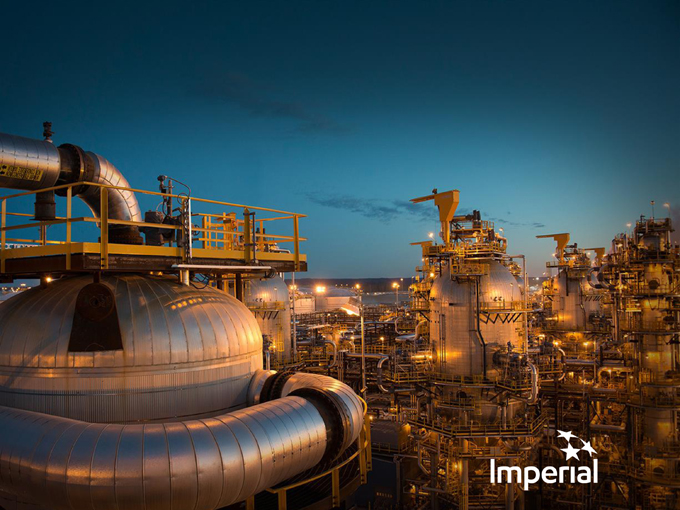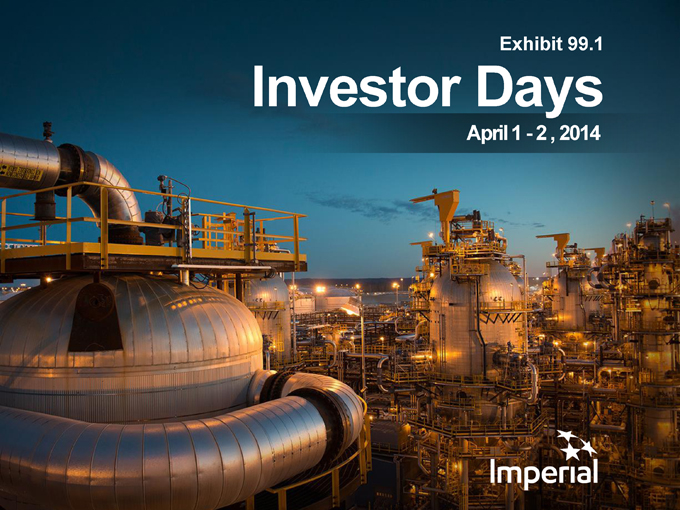
Exhibit 99.1
Investor Days
April 1—2 , 2014
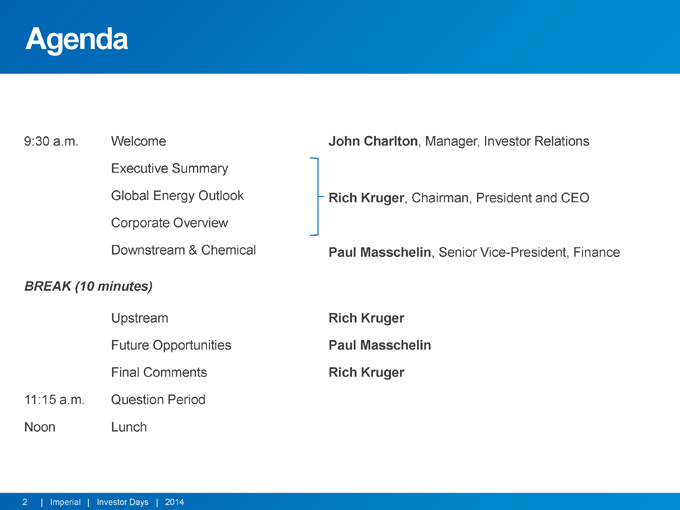
Agenda
9:30 a.m. Welcome John Charlton, Manager, Investor Relations
Executive Summary
Global Energy Outlook Rich Kruger, Chairman, President and CEO Corporate Overview
Downstream & Chemical Paul Masschelin, Senior Vice-President, Finance
BREAK (10 minutes)
Upstream Rich Kruger
Future Opportunities Paul Masschelin Final Comments Rich Kruger 11:15 a.m. Question Period Noon Lunch
2 | | | Imperial | Investor Days | 2014 |
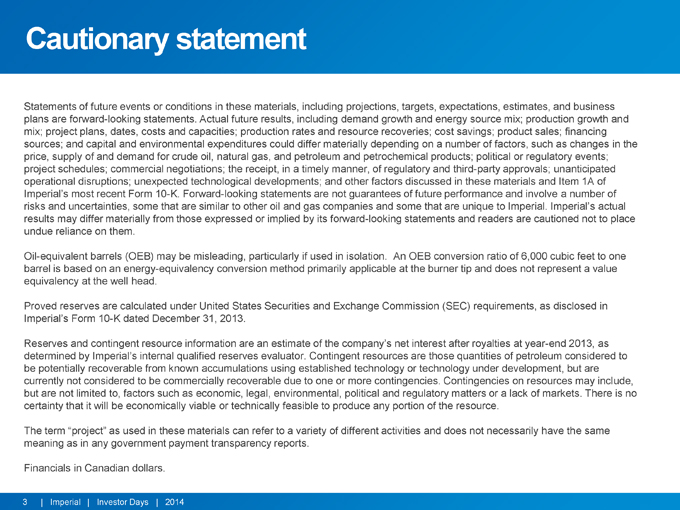
Cautionary statement
Statements of future events or conditions in these materials, including projections, targets, expectations, estimates, and business plans are forward-looking statements. Actual future results, including demand growth and energy source mix; production growth and mix; project plans, dates, costs and capacities; production rates and resource recoveries; cost savings; product sales; financing sources; and capital and environmental expenditures could differ materially depending on a number of factors, such as changes in the price, supply of and demand for crude oil, natural gas, and petroleum and petrochemical products; political or regulatory events; project schedules; commercial negotiations; the receipt, in a timely manner, of regulatory and third-party approvals; unanticipated operational disruptions; unexpected technological developments; and other factors discussed in these materials and Item 1A of Imperial’s most recent Form 10-K. Forward-looking statements are not guarantees of future performance and involve a number of risks and uncertainties, some that are similar to other oil and gas companies and some that are unique to Imperial. Imperial’s actual results may differ materially from those expressed or implied by its forward-looking statements and readers are cautioned not to place undue reliance on them.
Oil-equivalent barrels (OEB) may be misleading, particularly if used in isolation. An OEB conversion ratio of 6,000 cubic feet to one barrel is based on an energy-equivalency conversion method primarily applicable at the burner tip and does not represent a value equivalency at the well head.
Proved reserves are calculated under United States Securities and Exchange Commission (SEC) requirements, as disclosed in Imperial’s Form 10-K dated December 31, 2013.
Reserves and contingent resource information are an estimate of the company’s net interest after royalties at year-end 2013, as determined by Imperial’s internal qualified reserves evaluator. Contingent resources are those quantities of petroleum considered to be potentially recoverable from known accumulations using established technology or technology under development, but are currently not considered to be commercially recoverable due to one or more contingencies. Contingencies on resources may include, but are not limited to, factors such as economic, legal, environmental, political and regulatory matters or a lack of markets. There is no certainty that it will be economically viable or technically feasible to produce any portion of the resource.
The term “project” as used in these materials can refer to a variety of different activities and does not necessarily have the same meaning as in any government payment transparency reports.
Financials in Canadian dollars.
3 | | | Imperial | Investor Days | 2014 |
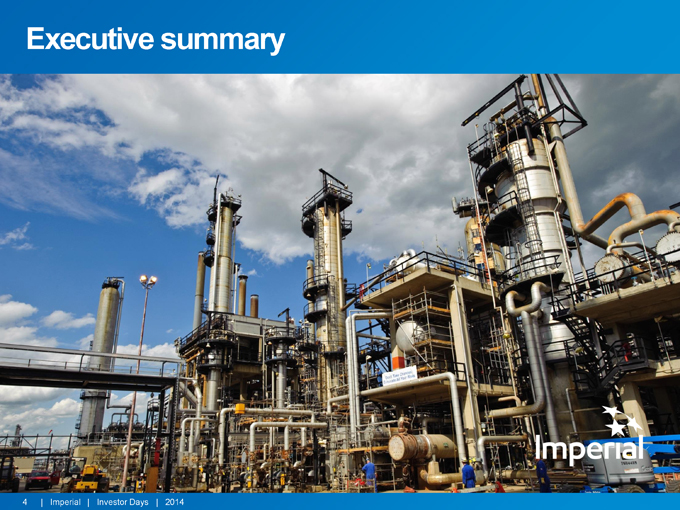
Executive summary
4 | | | Imperial | Investor Days | 2014 |
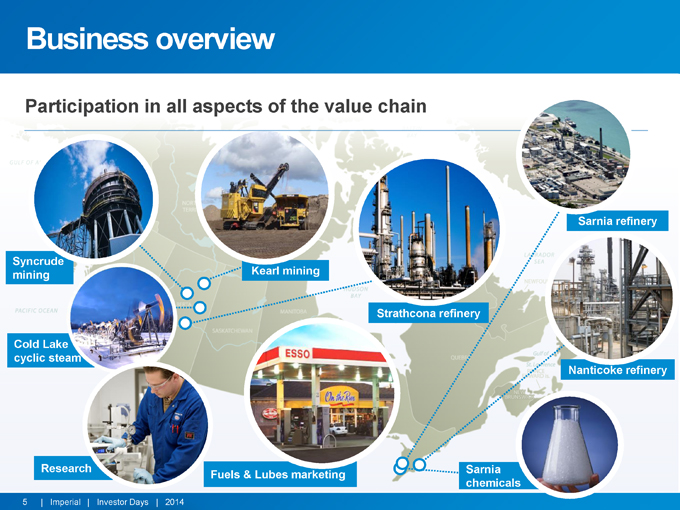
Business overview
Participation in all aspects of the value chain
Sarnia refinery
Syncrude Kearl mining mining
Strathcona refinery
Cold Lake cyclic steam
Nanticoke refinery
Research Sarnia Fuels & Lubes marketing chemicals
5 | | | Imperial | Investor Days | 2014 |
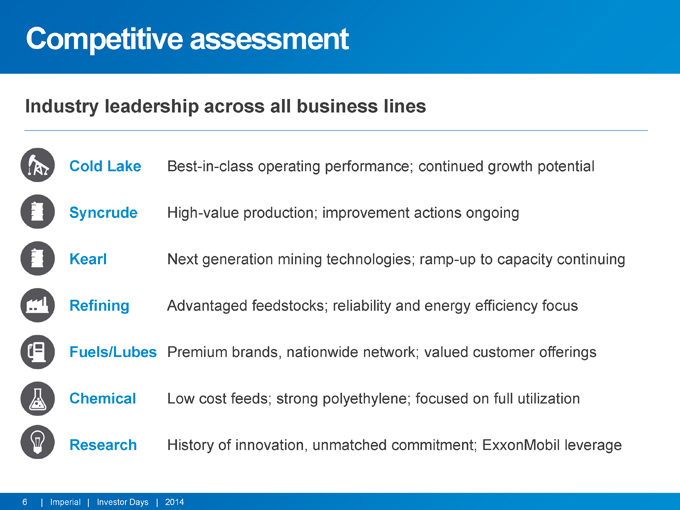
Competitive assessment
Industry leadership across all business lines
Cold Lake Best-in-class operating performance; continued growth potential Syncrude High-value production; improvement actions ongoing Kearl Next generation mining technologies; ramp-up to capacity continuing Refining Advantaged feedstocks; reliability and energy efficiency focus Fuels/Lubes Premium brands, nationwide network; valued customer offerings Chemical Low cost feeds; strong polyethylene; focused on full utilization Research History of innovation, unmatched commitment; ExxonMobil leverage
6 | | | Imperial | Investor Days | 2014 |
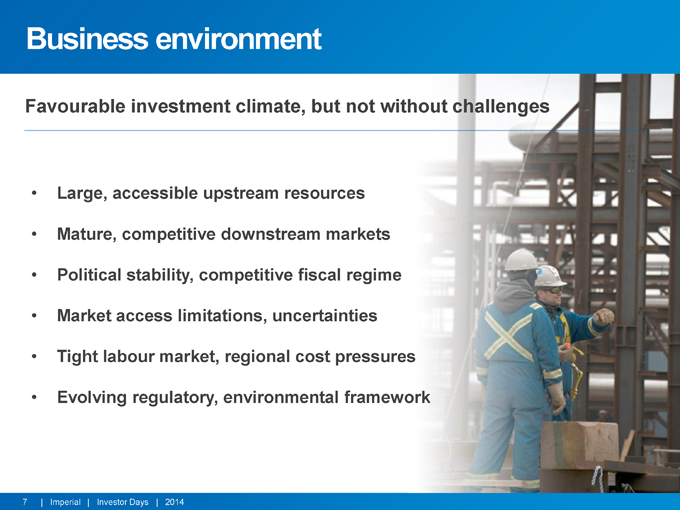
Business environment
Favourable investment climate, but not without challenges
• | | Large, accessible upstream resources |
• | | Mature, competitive downstream markets |
• | | Political stability, competitive fiscal regime |
• | | Market access limitations, uncertainties |
• | | Tight labour market, regional cost pressures |
• | | Evolving regulatory, environmental framework |
7 | | | Imperial | Investor Days | 2014 |
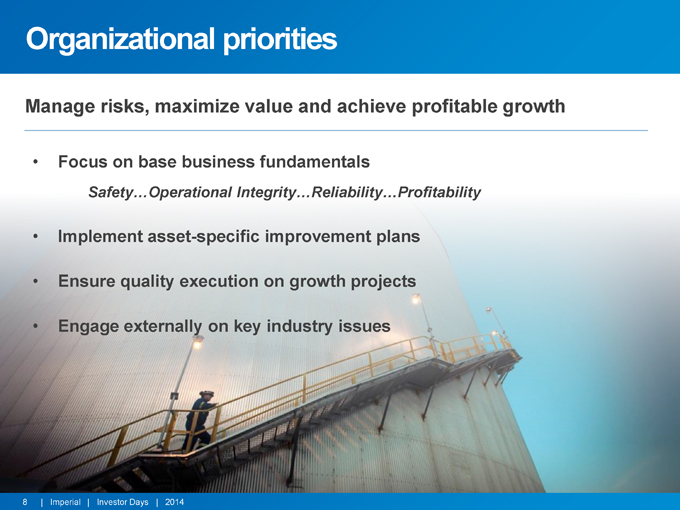
Organizational priorities
Manage risks, maximize value and achieve profitable growth
• | | Focus on base business fundamentals |
Safety…Operational Integrity…Reliability…Profitability
• | | Implement asset-specific improvement plans |
• | | Ensure quality execution on growth projects |
• | | Engage externally on key industry issues |
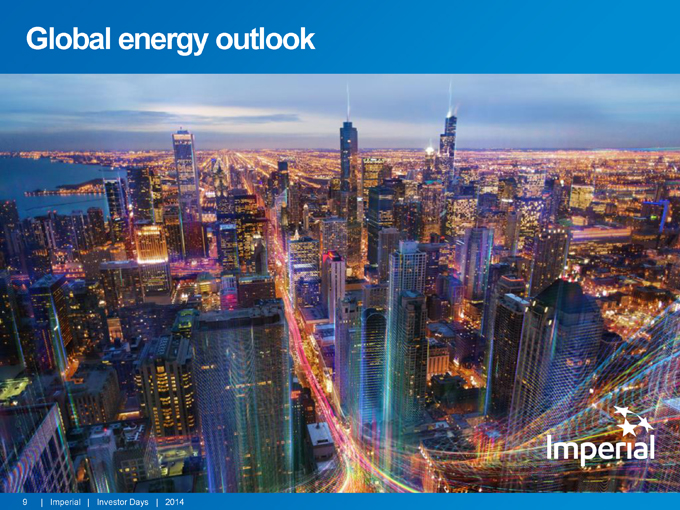
Global energy outlook
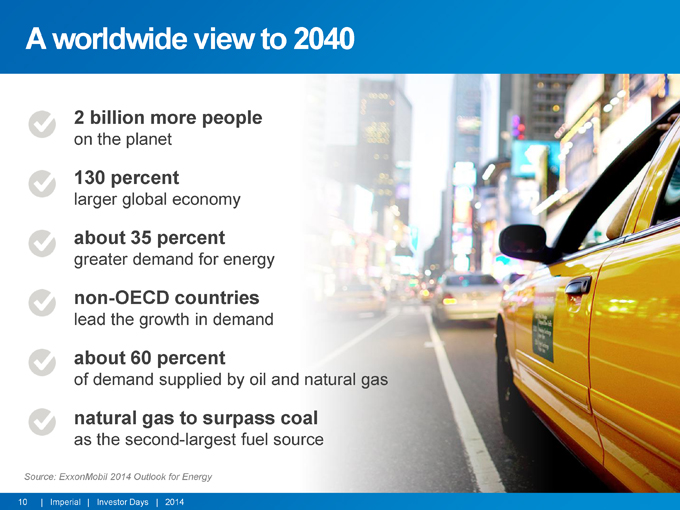
A worldwide view to 2040
on the planet
130 percent
larger global economy
about 35 percent
greater demand for energy
non-OECD countries
lead the growth in demand
about 60 percent
of demand supplied by oil and natural gas
natural gas to surpass coal
as the second-largest fuel source
Source: ExxonMobil 2014 Outlook for Energy
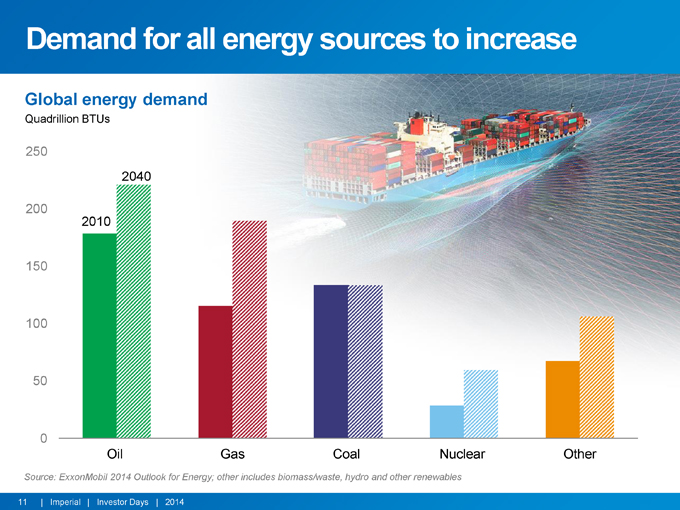
Demand for all energy sources to increase
Global energy demand
Quadrillion BTUs
250
2040
200
2010
150
100
50
0
Oil Gas Coal Nuclear Other
Source: ExxonMobil 2014 Outlook for Energy; other includes biomass/waste, hydro and other renewables
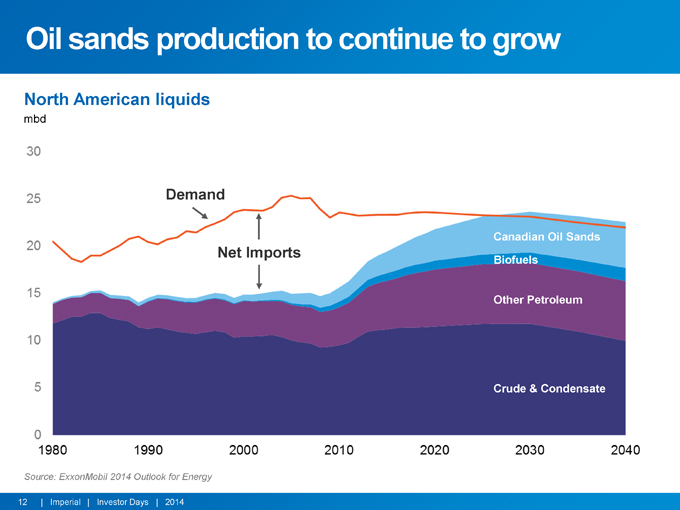
Oil sands production to continue to grow
North American liquids
mbd
Demand
Canadian Oil Sands
Net Imports
Biofuels
Other Petroleum
Crude & Condensate
Source: ExxonMobil 2014 Outlook for Energy
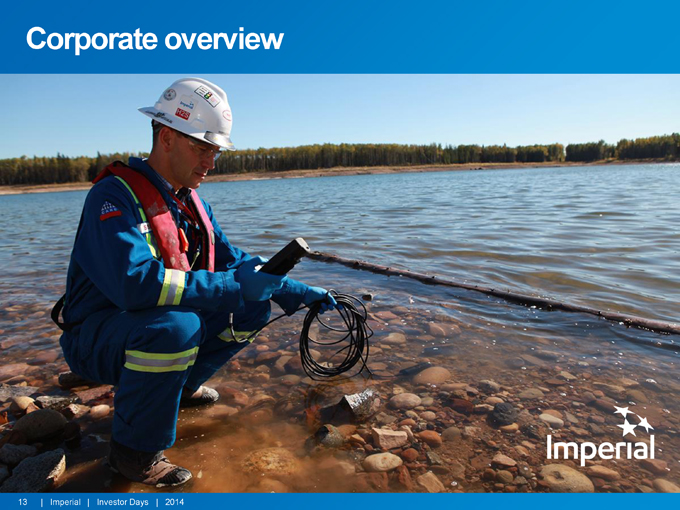
Corporate overview
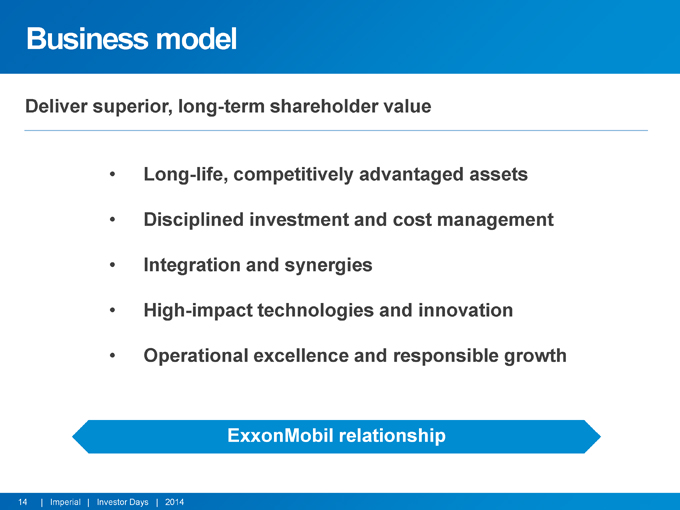
Business model
Deliver superior, long-term shareholder value
Long-life, competitively advantaged assets
Disciplined investment and cost management
Integration and synergies
High-impact technologies and innovation
Operational excellence and responsible growth
ExxonMobil relationship
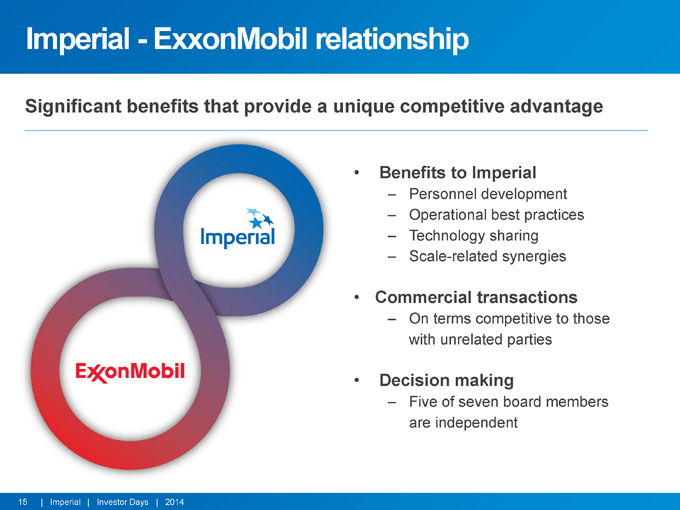
Imperial—ExxonMobil relationship
competitive advantage
nefits to Imperial
Personnel development Operational best practices Technology sharing Scale-related synergies
ercial transactions
On terms competitive to those with unrelated parties
cision making
Five of seven board members are independent
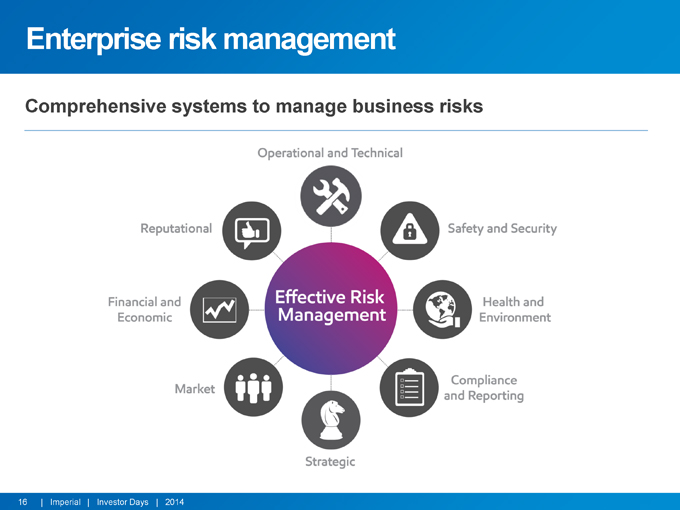
Enterprise risk management
Comprehensive systems to manage business risks
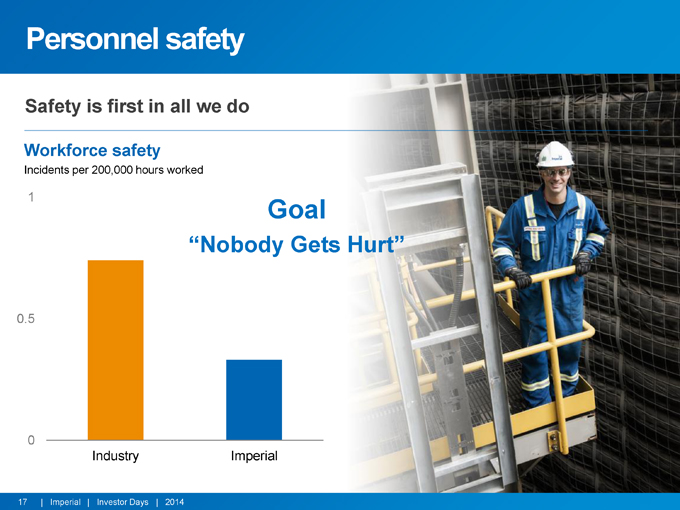
Personnel safety
Safety is first in all we do
Workforce safety
Incidents per 200,000 hours worked
“Nobody Gets Hurt”
0.5
0
Industry Imperial
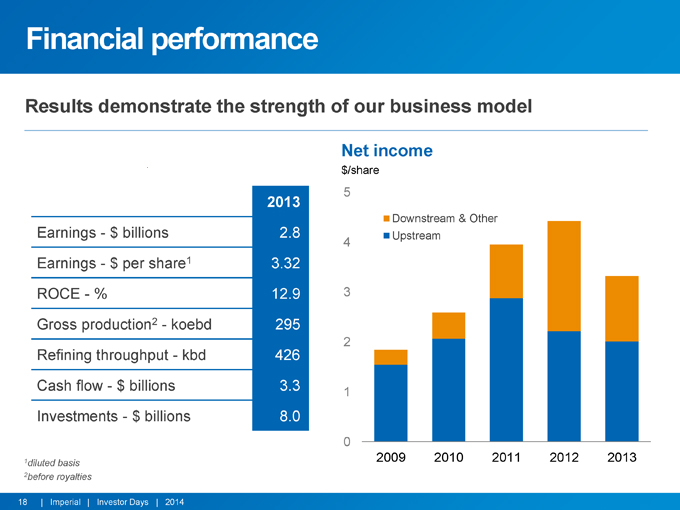
Financial performance
Results demonstrate the strength of our business model
Net income
$/share
2013
Downstream & Other
Earnings—$ billions 2.8 Upstream
Earnings—$ per share1 3.32 ROCE—% 12.9 3 Gross production2—koebd 295
Refining throughput���kbd 426
Cash flow—$ billions 3.3 1 Investments—$ billions 8.0
0
1 | | 2009 2010 2011 2012 2013 |
diluted basis 2before royalties
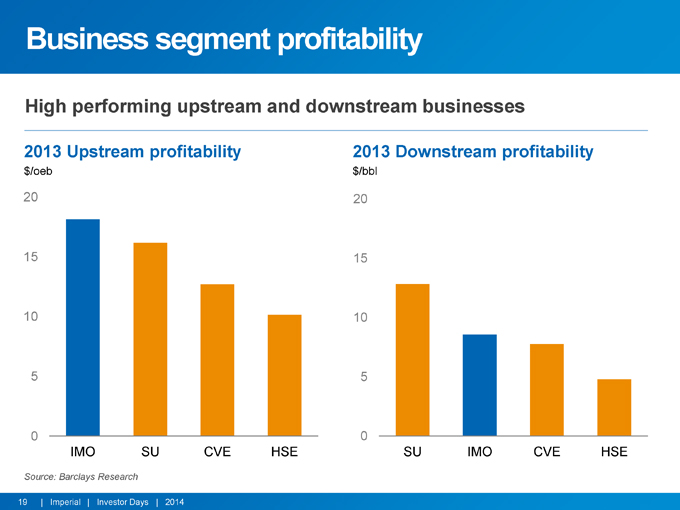
Business segment profitability
High performing upstream and downstream businesses
2013 Upstream profitability 2013 Downstream profitability
$/oeb $/bbl
20 20
15 15
10 10
0 0
IMO SU CVE HSE SU IMO CVE HSE
Source: Barclays Research
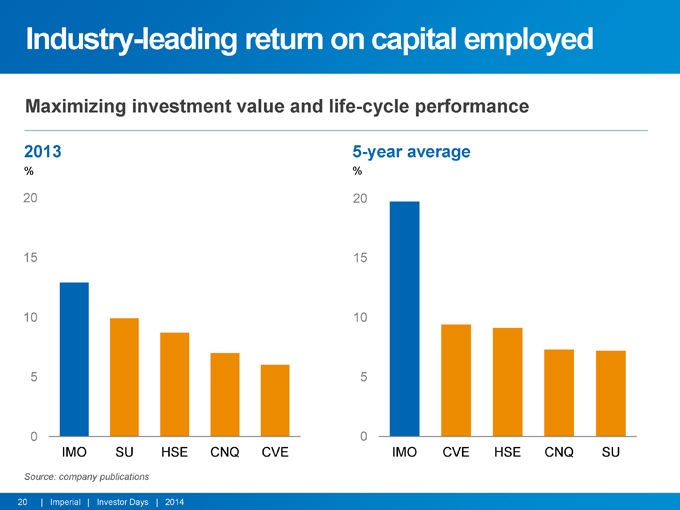
Industry-leading return on capital employed
Maximizing investment value and life-cycle performance
2013 5-year average
% %
20 20
15 15
10 10
0 0
IMO SU HSE CNQ CVE IMO CVE HSE CNQ SU
Source: company publications
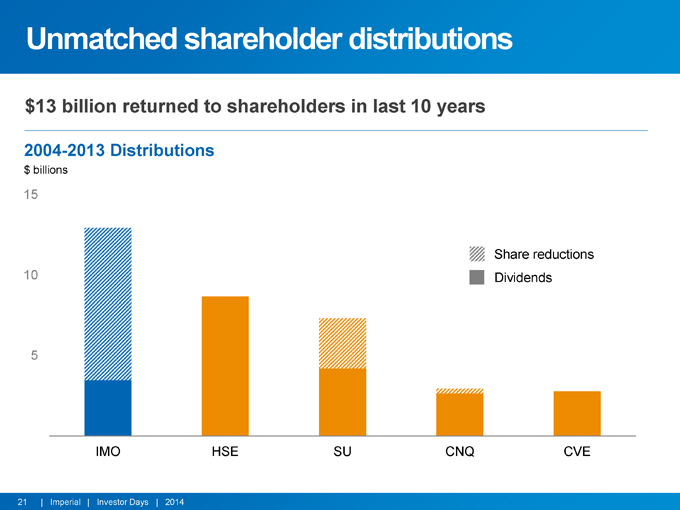
Unmatched shareholder distributions
$13 billion returned to shareholders in last 10 years
2004-2013 Distributions
$ billions
15
Share reductions
10 Dividends 5 IMO HSE SU CNQ CVE
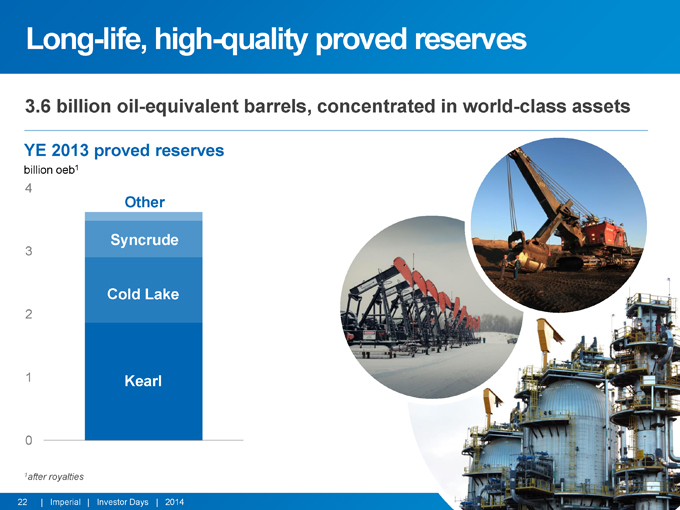
Long-life, high-quality proved reserves
3.6 billion oil-equivalent barrels, concentrated in world-class assets
YE 2013 proved reserves
billion oeb1
Other
Syncrude
Cold Lake
0
Year-end 2012
1after royalties
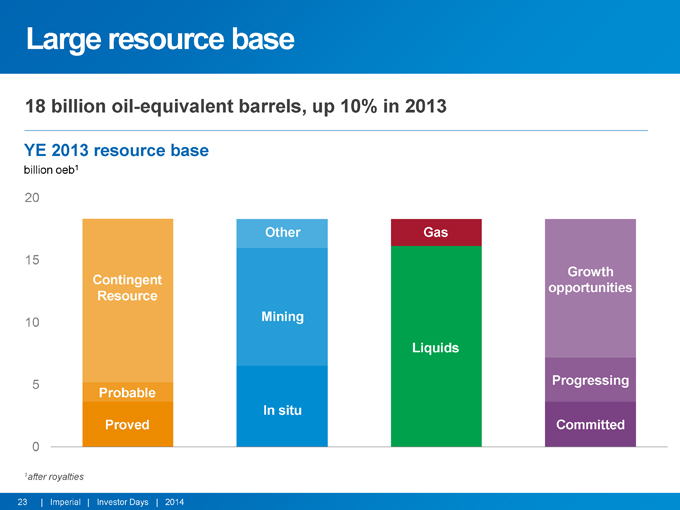
Large resource base
18 billion oil-equivalent barrels, up 10% in 2013
YE 2013 resource base
billion oeb1
20
Other Gas
15 Growth Contingent opportunities Resource
10 Mining
Liquids
5 | | Progressing Probable In situ Proved Committed |
0
1after royalties
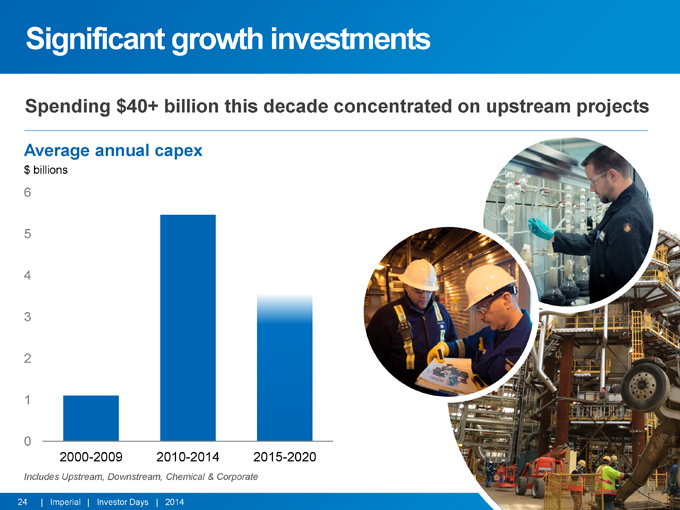
Significant growth investments
Spending $40+ billion this decade concentrated on upstream projects
Average annual capex
$ billions
0
2000-2009 2010-2014 2015-2020
Includes Upstream, Downstream, Chemical & Corporate
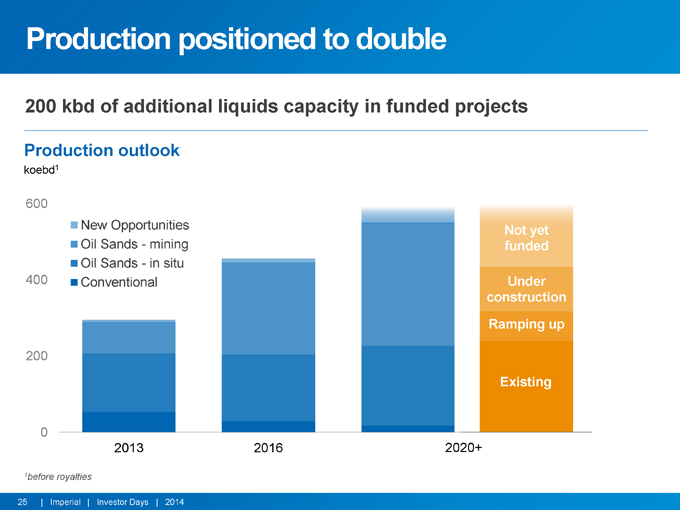
Production positioned to double
200 kbd of additional liquids capacity in funded projects
Production outlook
koebd1
600
New Opportunities Not yet Oil Sands—mining funded Oil Sands—in situ 400 Conventional Under construction
Ramping up
200
Existing
0
2013 2016 2020+
1before royalties
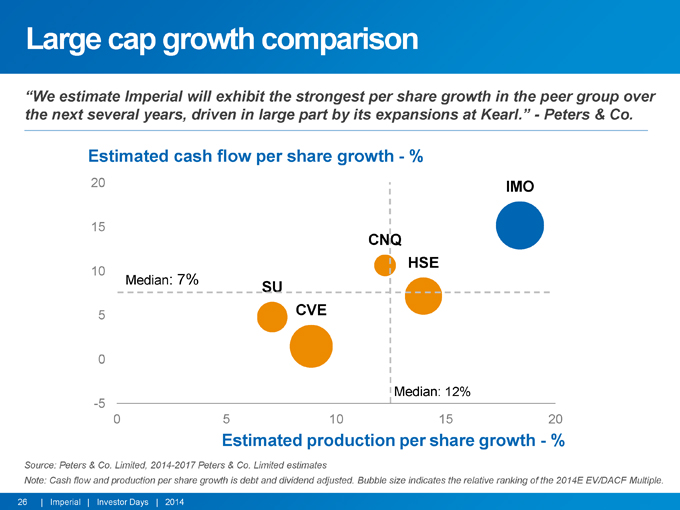
Large cap growth comparison
“We estimate Imperial will exhibit the strongest per share growth in the peer group over the next several years, driven in large part by its expansions at Kearl.”—Peters & Co.
Estimated cash flow per share growth—%
20 IMO
15 CNQ
HSE
10
Median: 7%
SU
0
-5 Median: 12%
0 5 10 15 20
Estimated production per share growth—%
Source: Peters & Co. Limited, 2014-2017 Peters & Co. Limited estimates
Note: Cash flow and production per share growth is debt and dividend adjusted. Bubble size indicates the relative ranking of the 2014E EV/DACF Multiple.
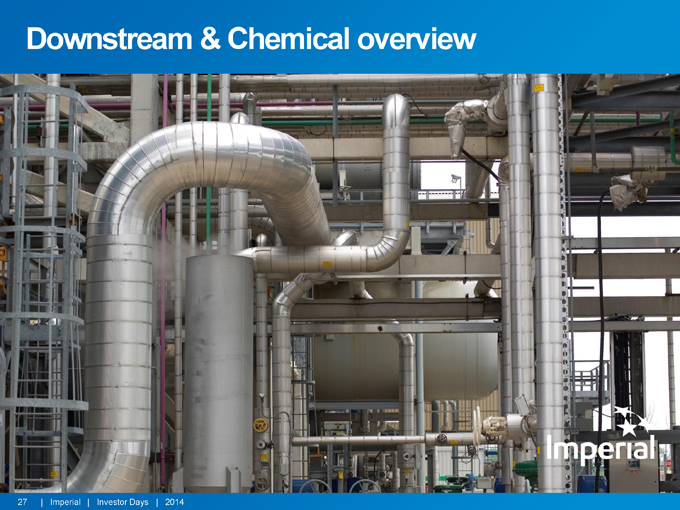
Downstream & Chemical overview
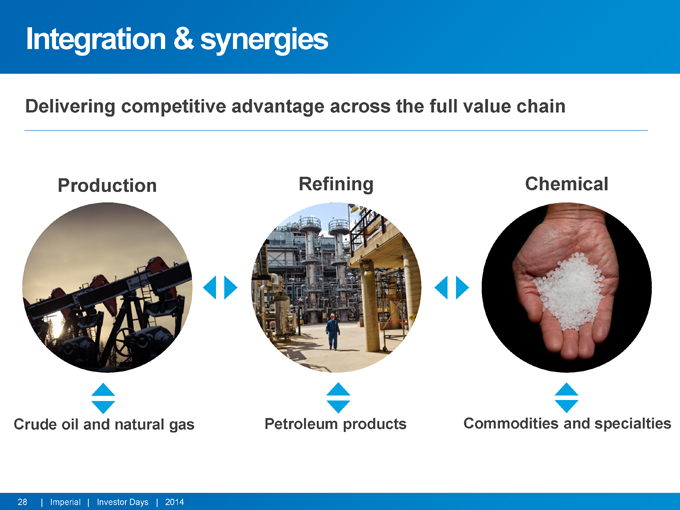
Integration & synergies
Delivering competitive advantage across the full value chain
Production Refining Chemical
Crude oil and natural gas Petroleum products Commodities and specialties
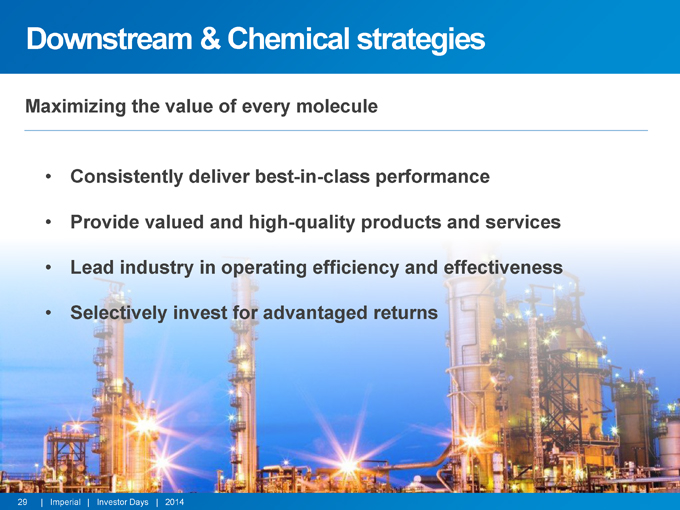
Downstream & Chemical strategies
Maximizing the value of every molecule
Consistently deliver best-in-class performance
Provide valued and high-quality products and services
Lead industry in operating efficiency and effectiveness
Selectively invest for advantaged returns
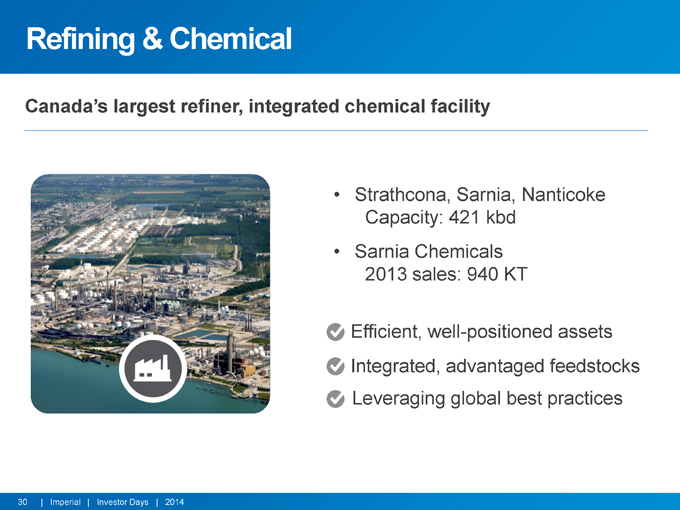
Refining & Chemical
Canada’s largest refiner, integrated chemical facility
Strathcona, Sarnia, Nanticoke Capacity: 421 kbd
Sarnia Chemicals 2013 sales: 940 KT
Efficient, well-positioned assets Integrated, advantaged feedstocks Leveraging global best practices
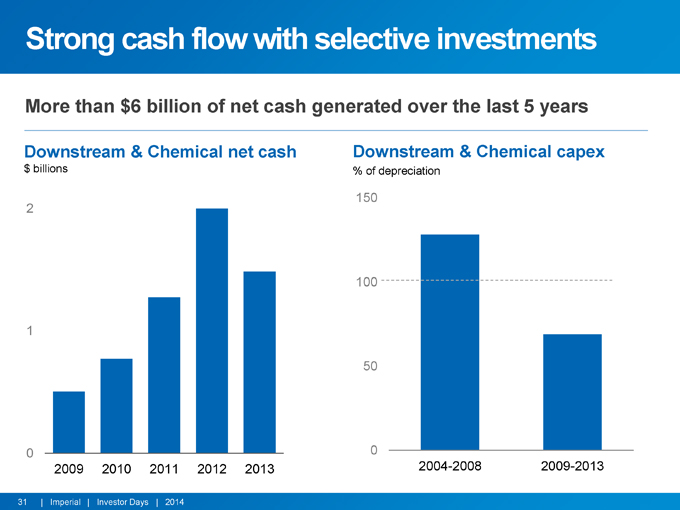
Strong cash flow with selective investments
More than $6 billion of net cash generated over the last 5 years
Downstream & Chemical net cash Downstream & Chemical capex
$ billions % of depreciation
150 2
100 1 50
0 0
2009 2010 2011 2012 2013 2004-2008 2009-2013
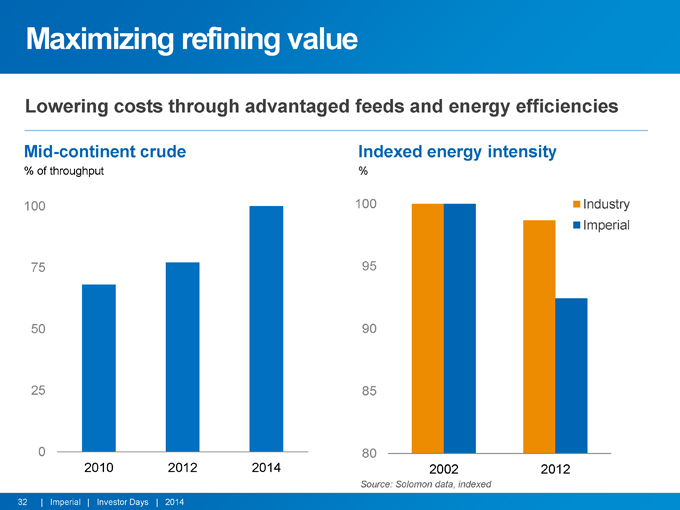
Maximizing refining value
Lowering costs through advantaged feeds and energy efficiencies
Mid-continent crude Indexed energy intensity
% of throughput %
100 100 Industry Imperial
75 95
50 90
25 85
0 80
2010 2012 2014 2002 2012
Source: Solomon data, indexed
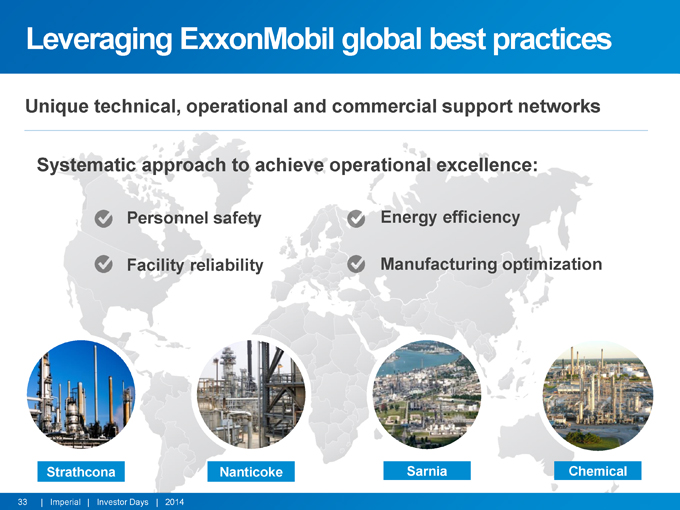
Leveraging ExxonMobil global best practices
Unique technical, operational and commercial support networks
Systematic approach to achieve operational excellence:
Personnel safety Energy efficiency
Facility reliability Manufacturing optimization
Strathcona Nanticoke Sarnia Chemical
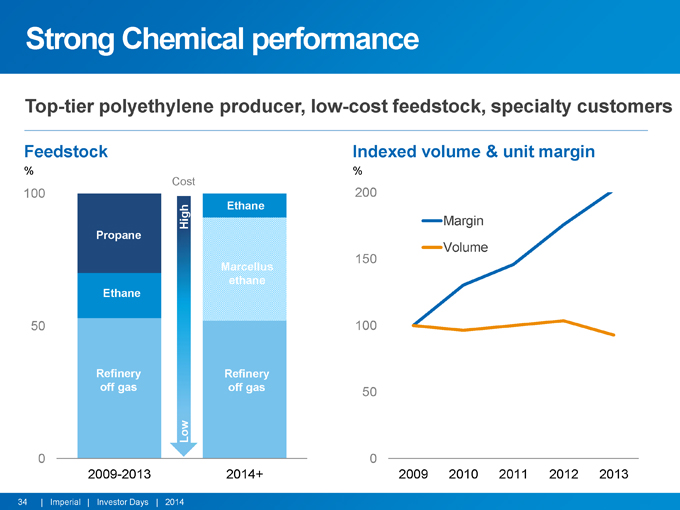
Strong Chemical performance
Top-tier polyethylene producer, low-cost feedstock, specialty customers
Feedstock Indexed volume & unit margin
% %
Cost 200
100
Ethane
High Margin
Propane
150 Volume
Marcellus ethane Ethane
50 100
Refinery Refinery off gas off gas 50
Low
0 0
2009-2013 2014+ 2009 2010 2011 2012 2013
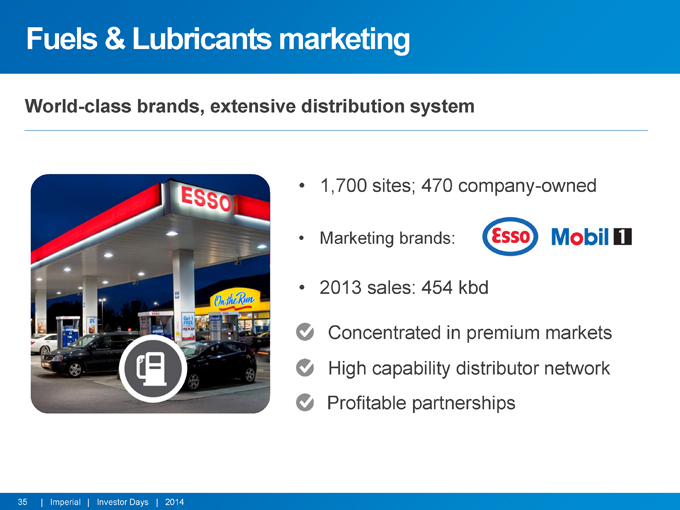
Fuels & Lubricants marketing
World-class brands, extensive distribution system
1,700 sites; 470 company-owned
Marketing brands:
2013 sales: 454 kbd
Concentrated in premium markets High capability distributor network Profitable partnerships
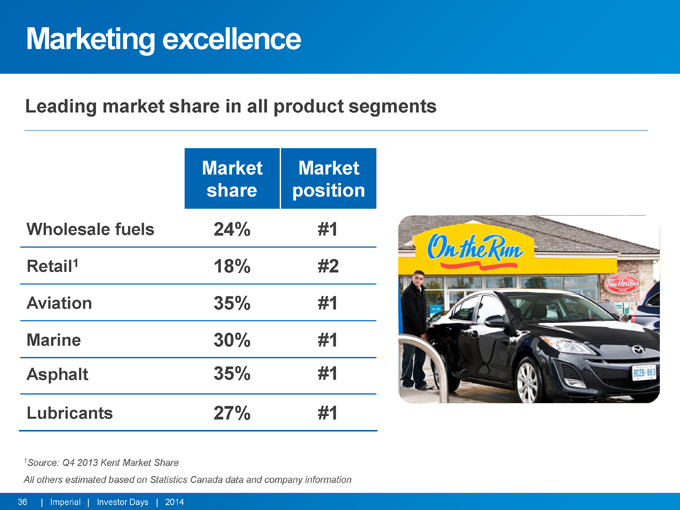
Marketing excellence
Leading market share in all product segments
Market Market share position
Wholesale fuels 24% #1 Retail1 18% #2
Aviation 35% #1
Marine 30% #1 Asphalt 35% #1
Lubricants 27% #1
1Source: Q4 2013 Kent Market Share
All others estimated based on Statistics Canada data and company information
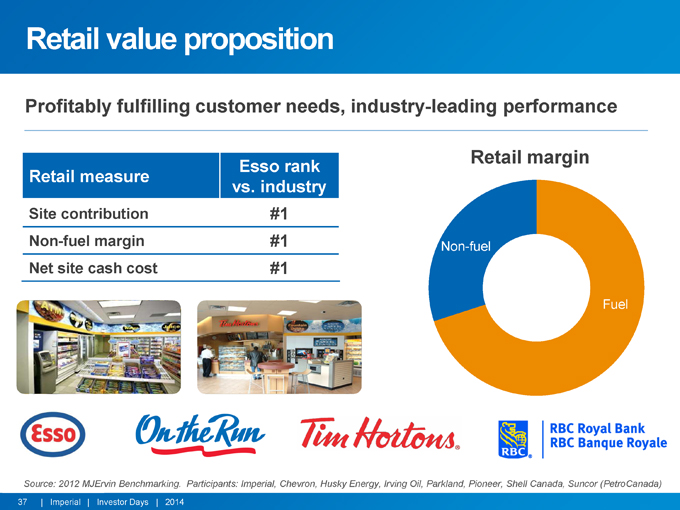
Retail value proposition
Profitably fulfilling customer needs, industry-leading performance
Retail margin
Esso rank
Retail measure vs. industry
Site contribution #1
Non-fuel margin #1 Non-fuel
Net site cash cost #1 Fuel
Non-fuel
Fuel
Source: 2012 MJErvin Benchmarking. Participants: Imperial, Chevron, Husky Energy, Irving Oil, Parkland, Pioneer, Shell Canada, Suncor (PetroCanada)
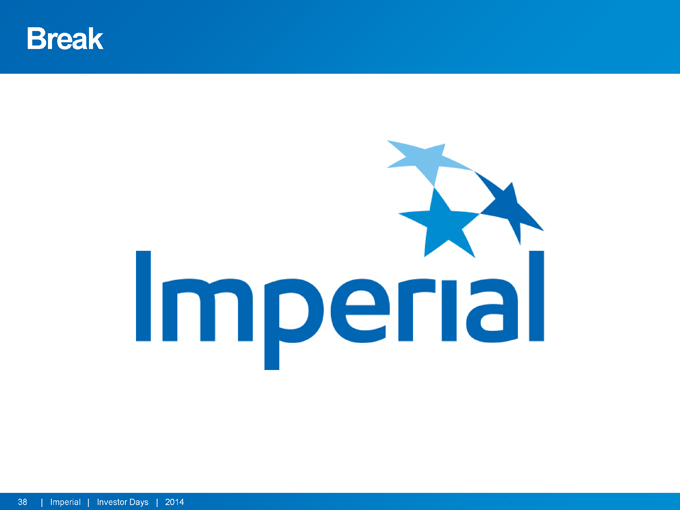
Break

Upstream overview
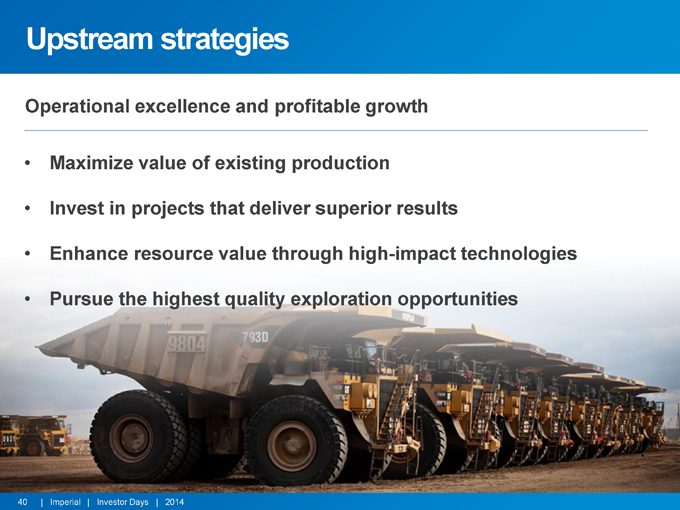
Upstream strategies
Operational excellence and profitable growth
• | | Maximize value of existing production |
• | | Invest in projects that deliver superior results |
• | | Enhance resource value through high-impact technologies |
• | | Pursue the highest quality exploration opportunities |
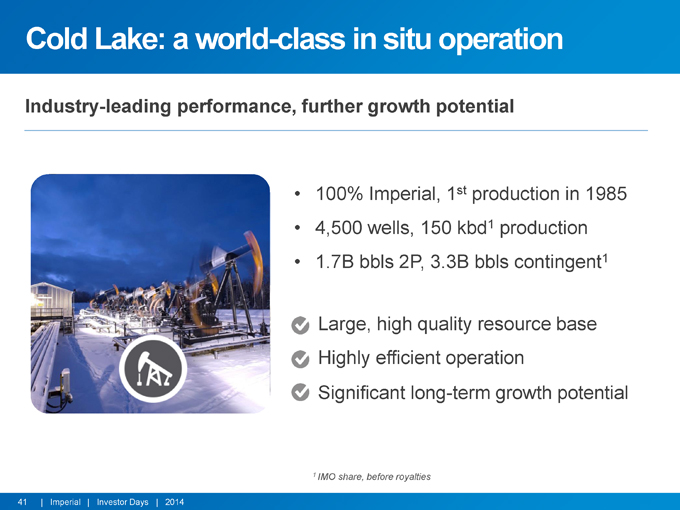
Cold Lake: a world-class in situ operation
Industry-leading performance, further growth potential
100% Imperial, 1st production in 1985
4,500 wells, 150 kbd1 production
1.7B bbls 2P, 3.3B bbls contingent1
Large, high quality resource base Highly efficient operation Significant long-term growth potential
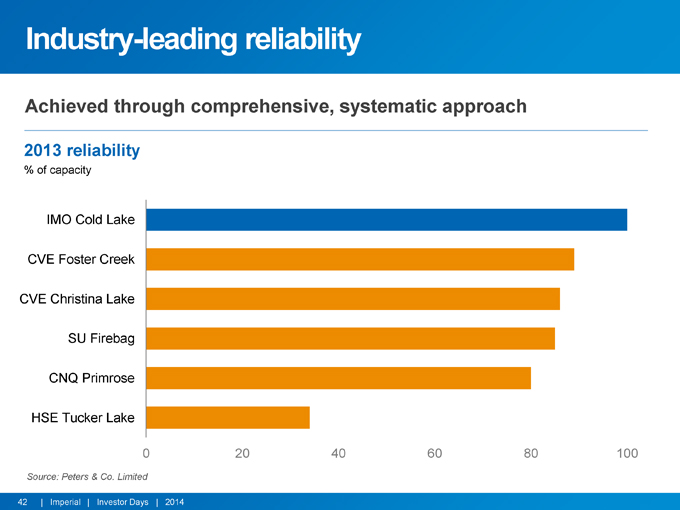
Industry-leading reliability
Achieved through comprehensive, systematic approach
2013 reliability
% of capacity
IMO Cold Lake CVE Foster Creek CVE Christina Lake SU Firebag CNQ Primrose HSE Tucker Lake
0 20 40 60 80 100
Source: Peters & Co. Limited
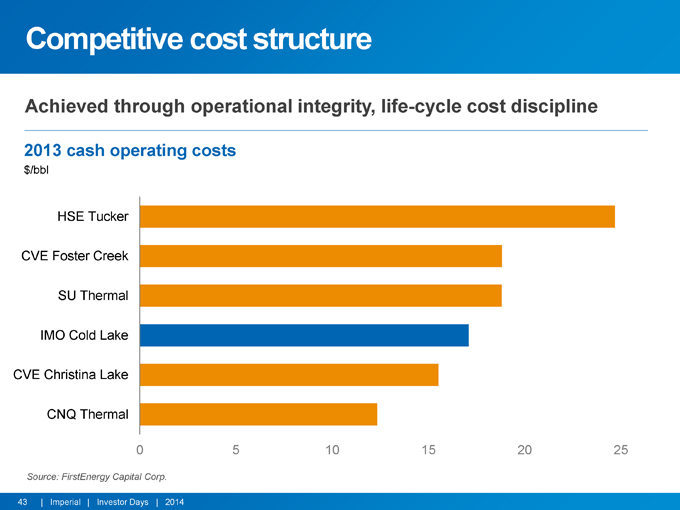
Competitive cost structure
Achieved through operational integrity, life-cycle cost discipline
2013 cash operating costs
$/bbl
HSE Tucker CVE Foster Creek SU Thermal IMO Cold Lake CVE Christina Lake CNQ Thermal
0 5 10 15 20 25
Source: FirstEnergy Capital Corp.
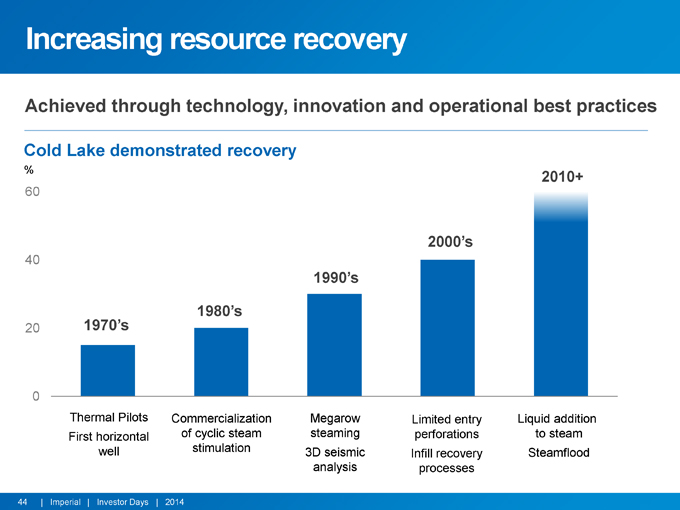
Increasing resource recovery
Achieved through technology, innovation and operational best practices
Cold Lake demonstrated recovery
% 2010+
60
2000’s
40
1990’s
1980’s
20 1970’s
0
Thermal Pilots Commercialization Megarow Limited entry Liquid addition First horizontal of cyclic steam steaming perforations to steam stimulation well 3D seismic Infill recovery Steamflood analysis processes
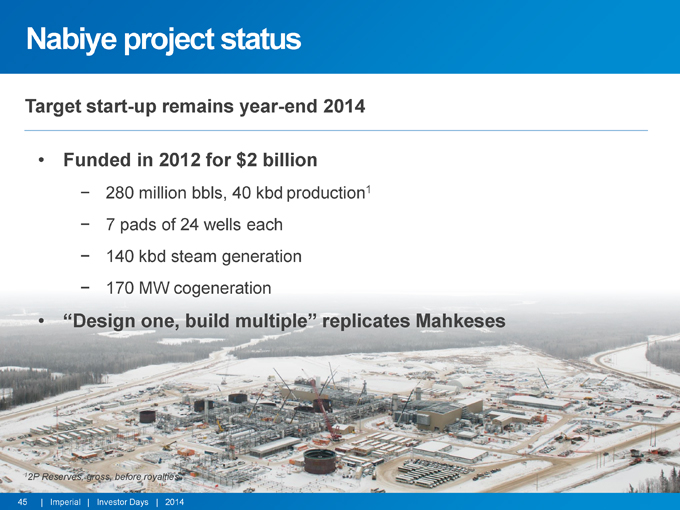
Nabiye project status
Target start-up remains year-end 2014
• | | Funded in 2012 for $2 billion |
- 280 million bbls, 40 kbd production1
- 7 pads of 24 wells each
- 140 kbd steam generation
- 170 MW cogeneration
• | | “Design one, build multiple” replicates Mahkeses |
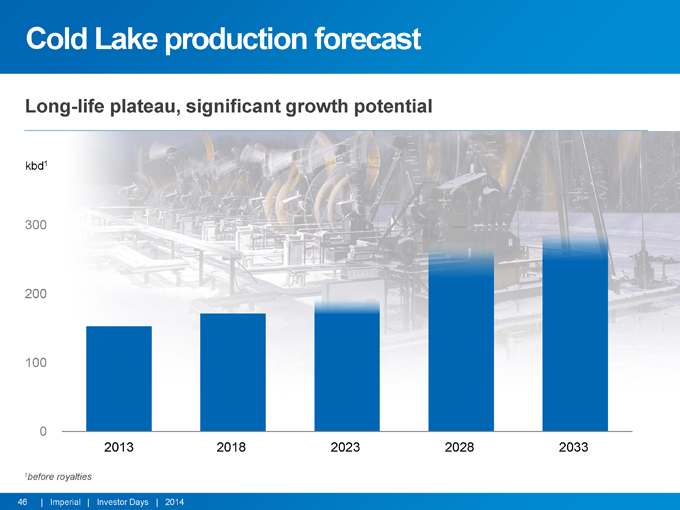
Cold Lake production forecast
Long-life plateau, significant growth potential
kbd1
300 200 100
0
2013 2018 2023 2028 2033
1before royalties
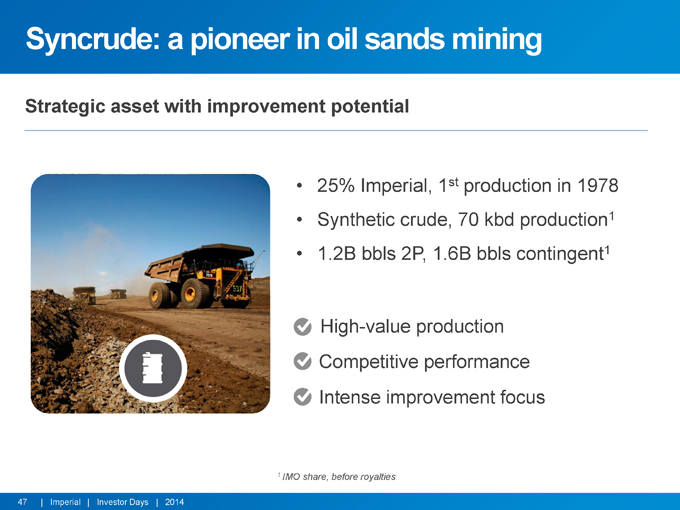
Syncrude: a pioneer in oil sands mining
Strategic asset with improvement potential
25% Imperial, 1st production in 1978
Synthetic crude, 70 kbd production1
1.2B bbls 2P, 1.6B bbls contingent1
High-value production Competitive performance Intense improvement focus
1 IMO share, before royalties
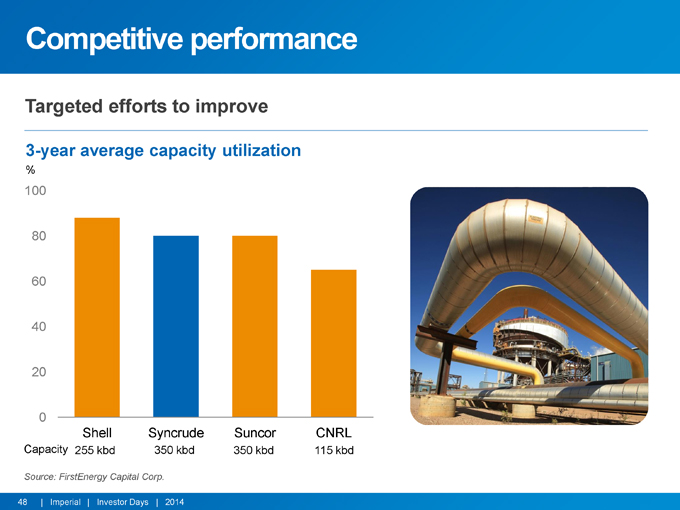
Competitive performance
Targeted efforts to improve
3-year average capacity utilization
%
100 80 60 40 20
0
Shell Syncrude Suncor CNRL
Capacity 255 kbd 350 kbd 350 kbd 115 kbd
Source: FirstEnergy Capital Corp.
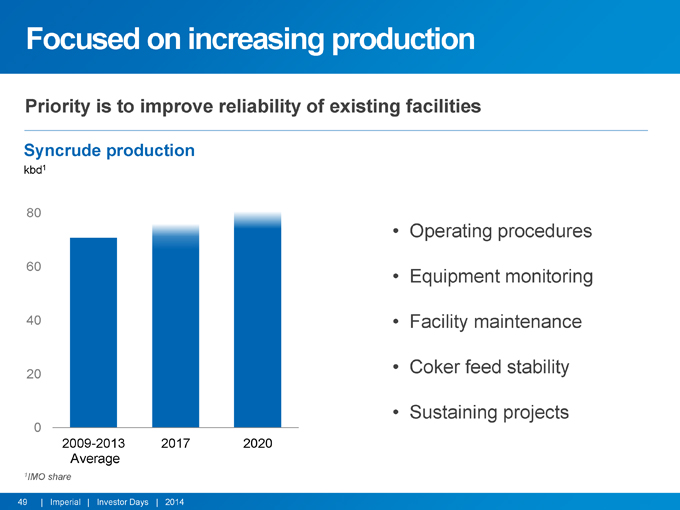
Focused on increasing production
Priority is to improve reliability of existing facilities
Syncrude production
kbd1
80
Operating procedures
60
Equipment monitoring
40 • Facility maintenance
20 • Coker feed stability
Sustaining projects
0
2009-2013 2017 2020 Average
1IMO share
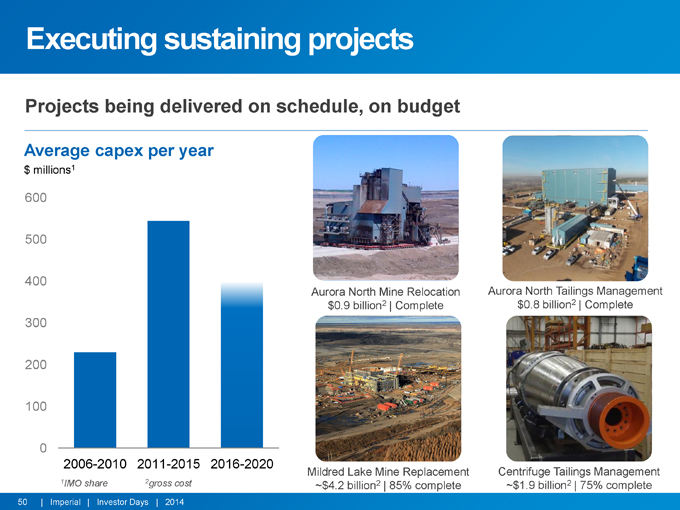
Executing sustaining projects
Projects being delivered on schedule, on budget
Average capex per year
$ millions1
600
500
400
Aurora North Mine Relocation Aurora North Tailings Management $0.9 billion2 | Complete $0.8 billion2 | Complete
300 200 100
0
2006-2010 2011-2015 2016-2020
Mildred Lake Mine Replacement Centrifuge Tailings Management 1IMO share 2gross cost ~$4.2 billion2 | 85% complete ~$1.9 billion2 | 75% complete
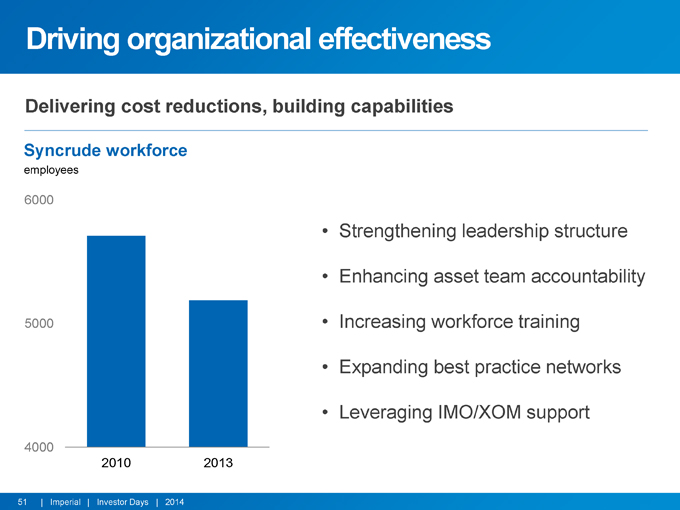
Driving organizational effectiveness
Delivering cost reductions, building capabilities
Syncrude workforce
employees
6000
Strengthening leadership structure
Enhancing asset team accountability 5000 Increasing workforce training
Expanding best practice networks
Leveraging IMO/XOM support
4000
2010 2013
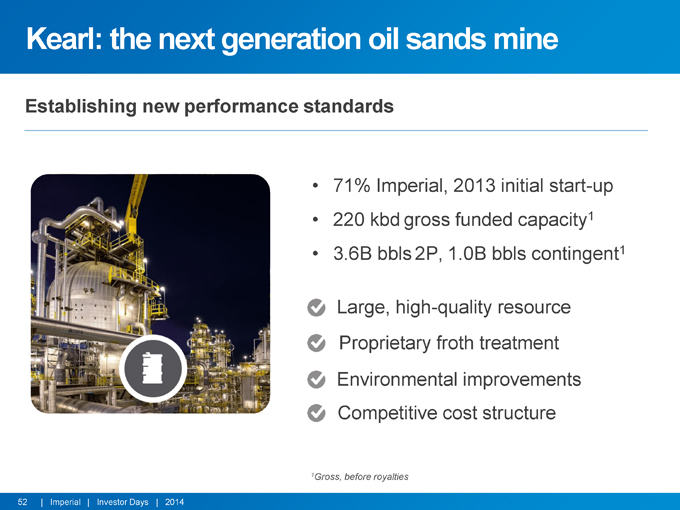
Kearl: the next generation oil sands mine
Establishing new performance standards
71% Imperial, 2013 initial start-up
220 kbd gross funded capacity1
3.6B bbls 2P, 1.0B bbls contingent1
Large, high-quality resource Proprietary froth treatment Environmental improvements Competitive cost structure
1Gross, before royalties
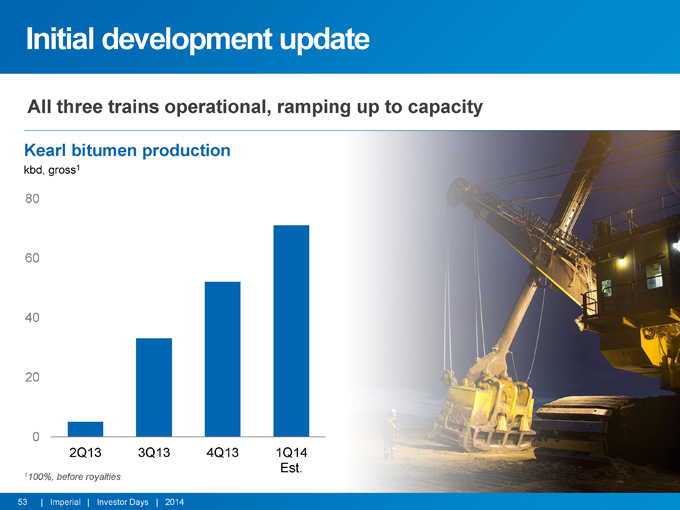
Initial development update
All three trains operational, ramping up to capacity
Kearl bitumen production
kbd, gross1
80 60 40 20
0
2Q13 3Q13 4Q13 1Q14 Est.
1100%, before royalties
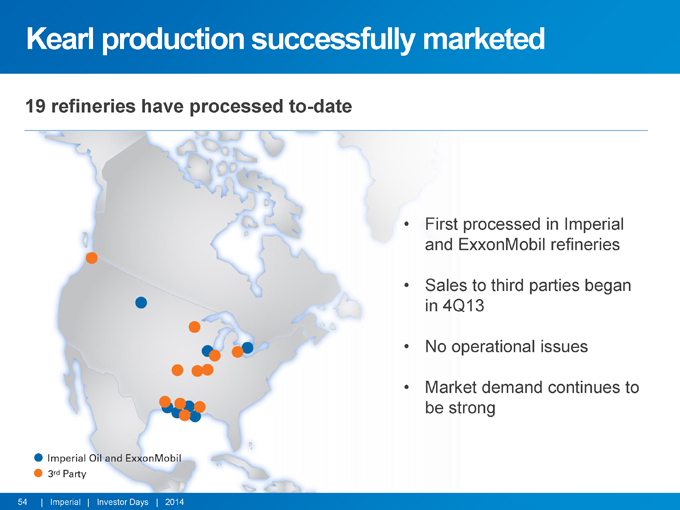
Kearl production successfully marketed
19 refineries have processed to-date
First processed in Imperial and ExxonMobil refineries
Sales to third parties began in 4Q13
No operational issues
Market demand continues to be strong
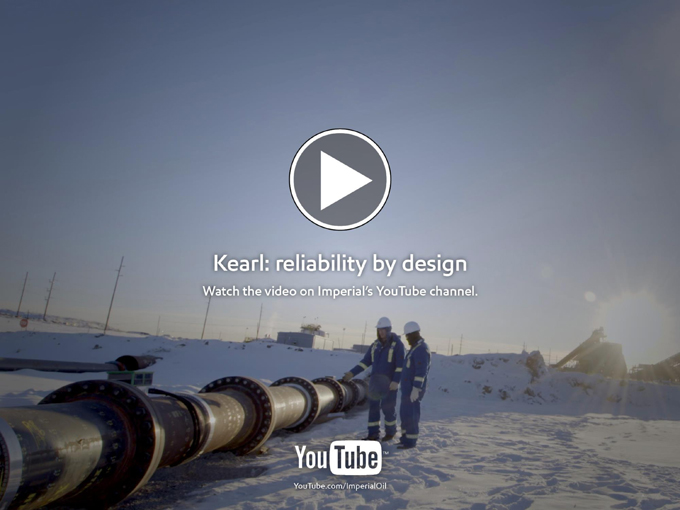
YOUTUBE
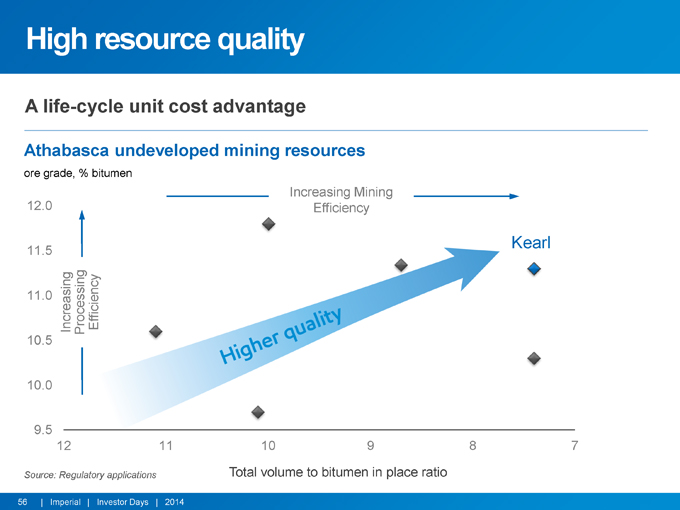
High resource quality
A life-cycle unit cost advantage
Athabasca undeveloped mining resources
ore grade, % bitumen
Increasing Mining 12.0 Efficiency
Kearl
11.5
11.0 Increasing Processing Efficiency 10.5
10.0
9.5
12 11 10 9 8 7 Source: Regulatory applications Total volume to bitumen in place ratio
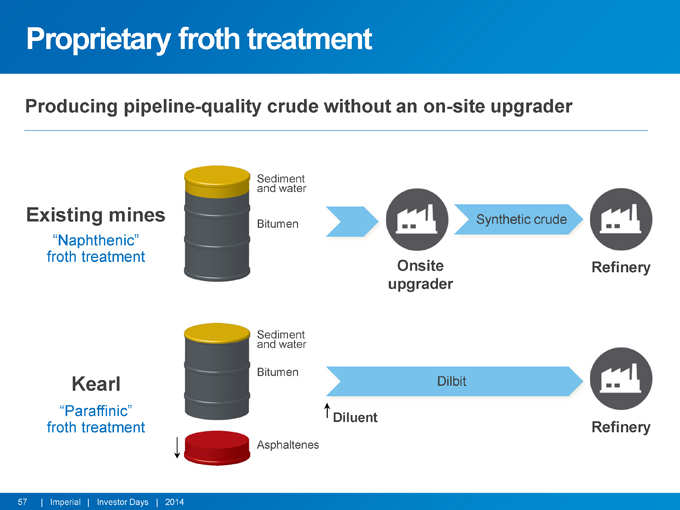
Proprietary froth treatment
Producing pipeline-quality crude without an on-site upgrader
Sediment and water
Existing mines Synthetic crude
Bitumen
“Naphthenic” froth treatment
Onsite Refinery upgrader
Sediment and water
Bitumen
Kearl Dilbit
“Paraffinic”
Diluent froth treatment Refinery
Asphaltenes
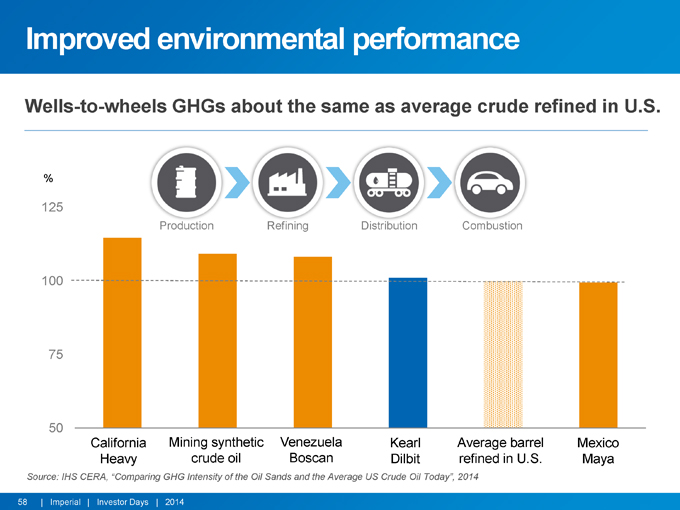
Improved environmental performance
Wells-to-wheels GHGs about the same as average crude refined in U.S.
%
125
Production Refining Distribution Combustion
100
75
50
California Mining synthetic Venezuela Kearl Average barrel Mexico Heavy crude oil Boscan Dilbit refined in U.S. Maya
Source: IHS CERA, “Comparing GHG Intensity of the Oil Sands and the Average US Crude Oil Today”, 2014
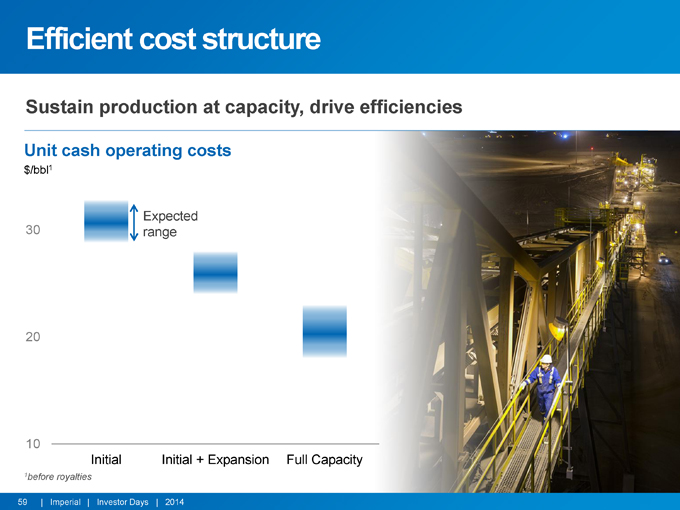
Efficient cost structure
Sustain production at capacity, drive efficiencies
Unit cash operating costs
$/bbl1
Expected 30 range
20
10
Initial Initial + Expansion Full Capacity
1before royalties
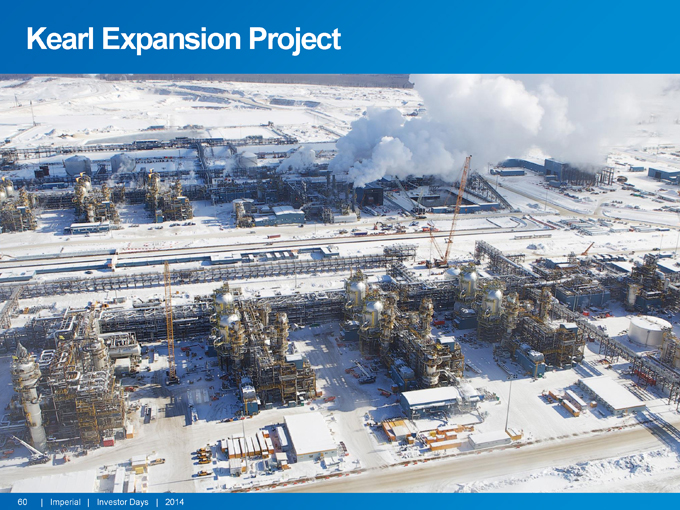
Kearl Expansion Project
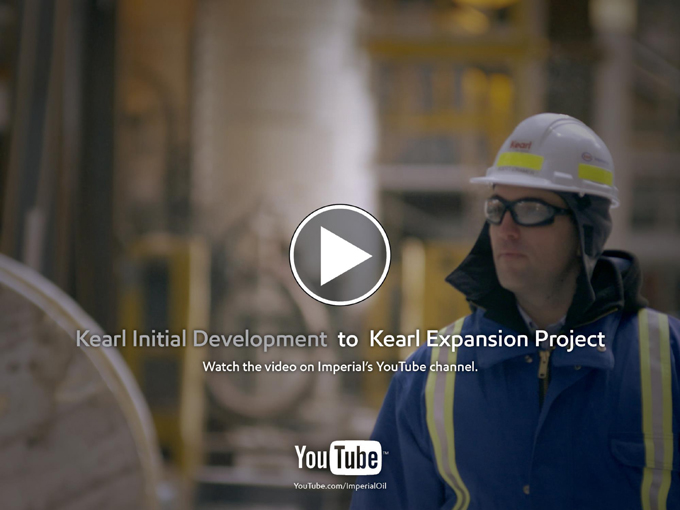
YOUTUBE
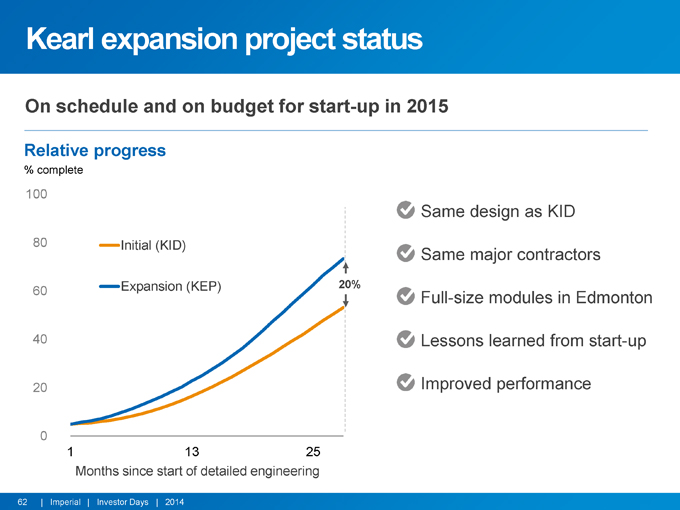
Kearl expansion project status
On schedule and on budget for start-up in 2015
Relative progress
% complete
100%
Same design as KID
80% Initial (KID)
Same major contractors
Expansion (KEP) 20%
60% Full-size modules in Edmonton
40% Lessons learned from start-up
20% Improved performance
1 | | 13 25 Months since start of detailed engineering |
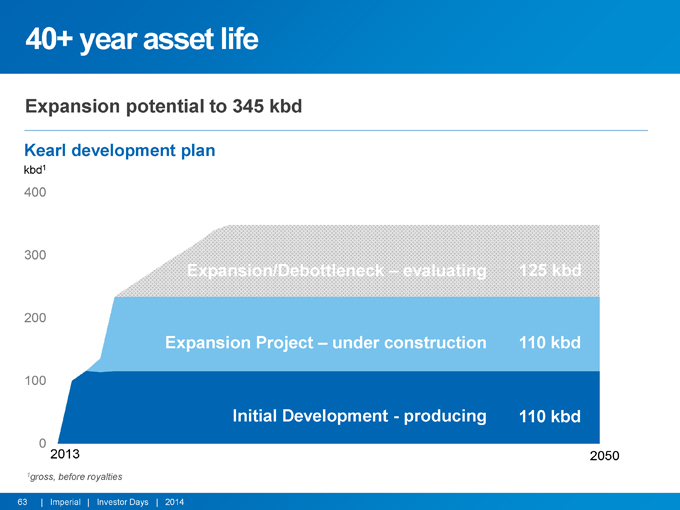
40+ year asset life
Expansion potential to 345 kbd
Kearl development plan
kbd1
400
300
Expansion/Debottleneck – evaluating 125 kbd
200
Expansion Project – under construction 110 kbd
100
Initial Development—producing 110 kbd
0
2013 2050
1gross, before royalties

Market access strategy
Ensure take-away capacity for all equity crude
Optimize use of existing systems to maximize value
Participate in multiple new pipeline opportunities
Use rail options to bridge and provide contingency
Mitigate any future surplus via portfolio optimizations
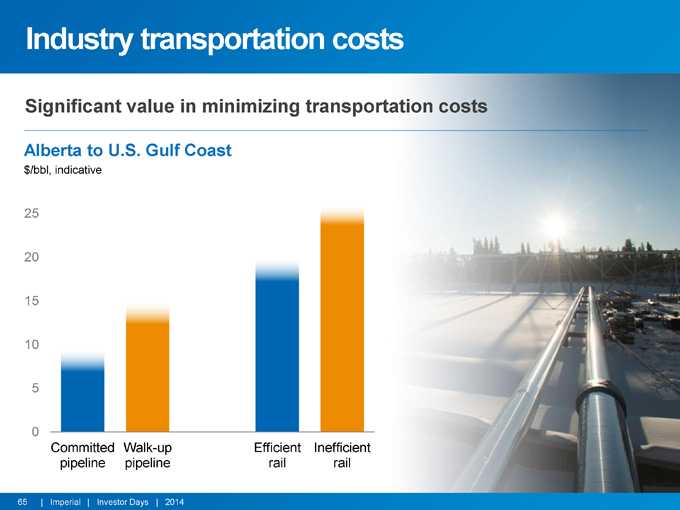
Industry transportation costs
Significant value in minimizing transportation costs
Alberta to U.S. Gulf Coast
$/bbl, indicative
25 20 15 10 5
0
Committed Walk-up Efficient Inefficient pipeline pipeline rail rail
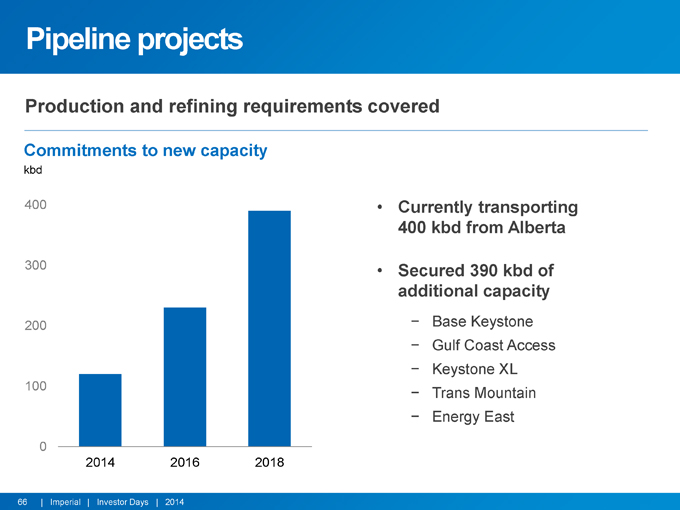
Pipeline projects
Production and refining requirements covered
Commitments to new capacity
kbd
400
Currently transporting 400 kbd from Alberta
300 • Secured 390 kbd of additional capacity
200—Base Keystone
- Gulf Coast Access
- Keystone XL
100
- Trans Mountain
- Energy East
0
2014 2016 2018
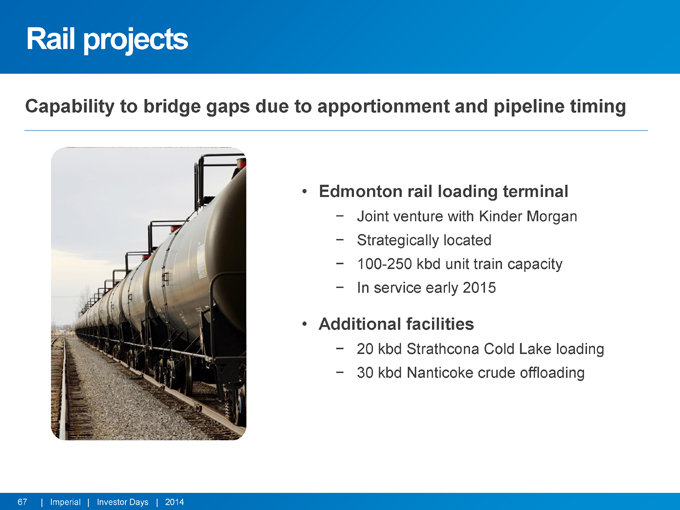
Rail projects
Capability to bridge gaps due to apportionment and pipeline timing
Edmonton rail loading terminal
- Joint venture with Kinder Morgan
- Strategically located
- 100-250 kbd unit train capacity
- In service early 2015
Additional facilities
- 20 kbd Strathcona Cold Lake loading
- 30 kbd Nanticoke crude offloading
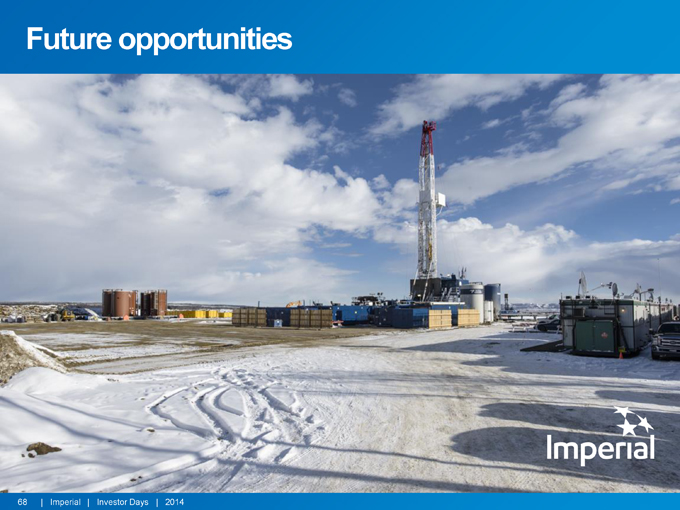
Future opportunities
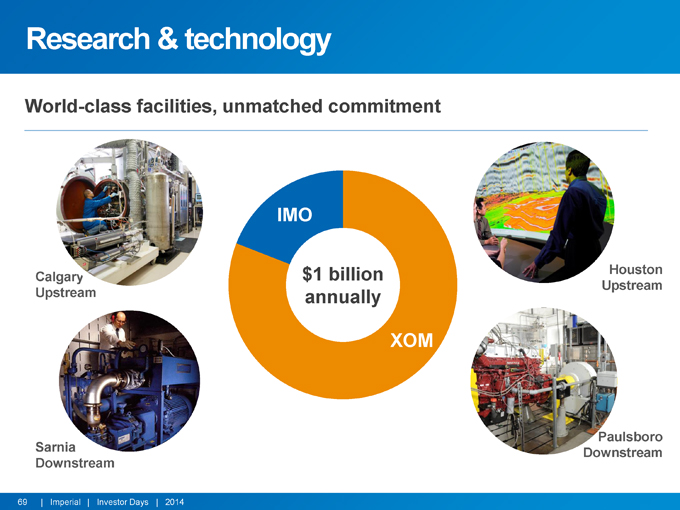
Research & technology
World-class facilities, unmatched commitment
IMO
$1 billion Houston
Calgary
Upstream Upstream annually
XOM
Paulsboro Sarnia Downstream Downstream

Oil sands research
A history of success, new technologies being advanced
In situ In situ Mining
SA-SAGD CSP NAE
Solvent-assisted Cyclic solvent Non-aqueous SAGD process extraction
Deliver performance improvements and long-term value
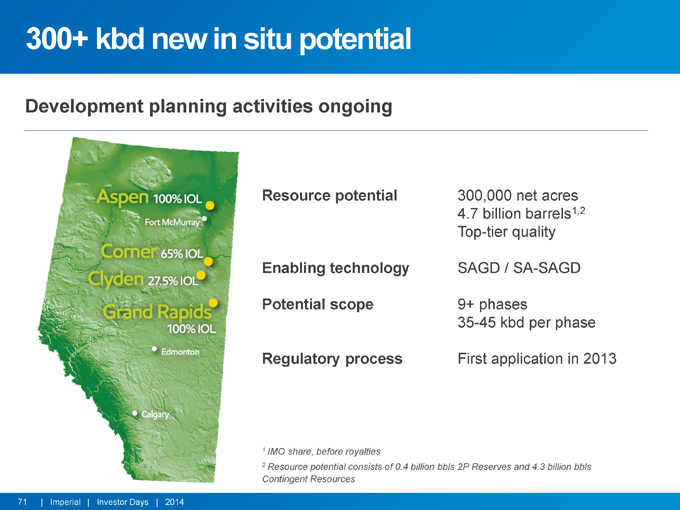
300+ kbd new in situ potential
Development planning activities ongoing
Resource potential 300,000 net acres 4.7 billion barrels1,2 Top-tier quality
Enabling technology SAGD / SA-SAGD
Potential scope 9+ phases
35-45 kbd per phase
Regulatory process First application in 2013
1 | | IMO share, before royalties |
2 | | Resource potential consists of 0.4 billion bbls 2P Reserves and 4.3 billion bbls Contingent Resources |
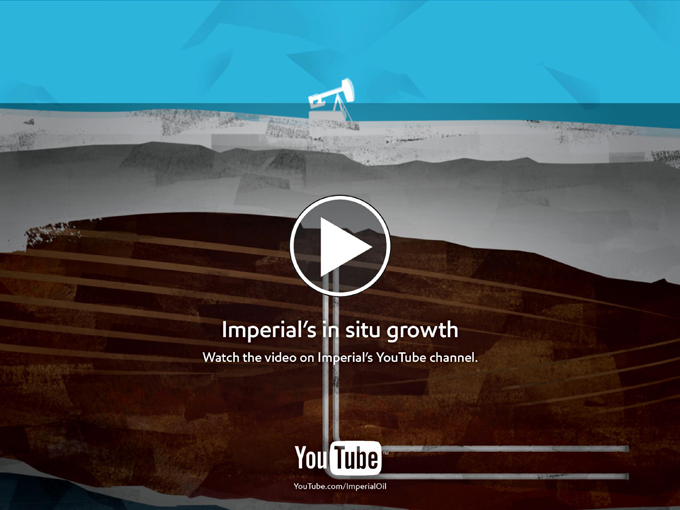
YOUTUBE
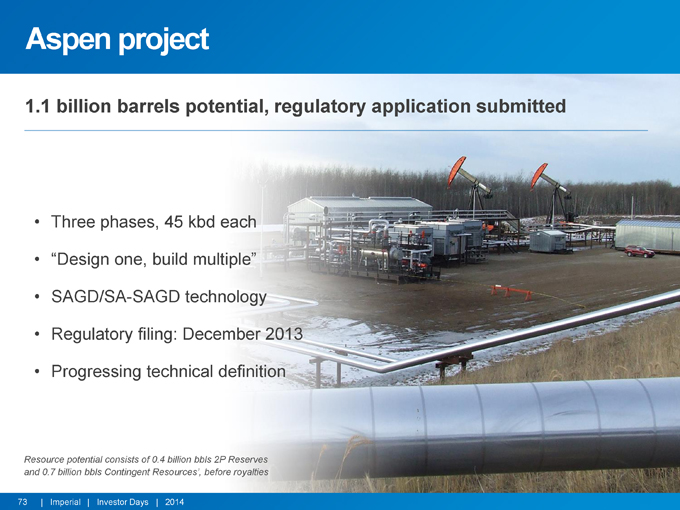
Aspen project
1.1 billion barrels potential, regulatory application submitted
Three phases, 45 kbd each
“Design one, build multiple”
SAGD/SA-SAGD technology
Regulatory filing: December 2013
Progressing technical definition
Resource potential consists of 0.4 billion bbls 2P Reserves and 0.7 billion bbls Contingent Resources’, before royalties
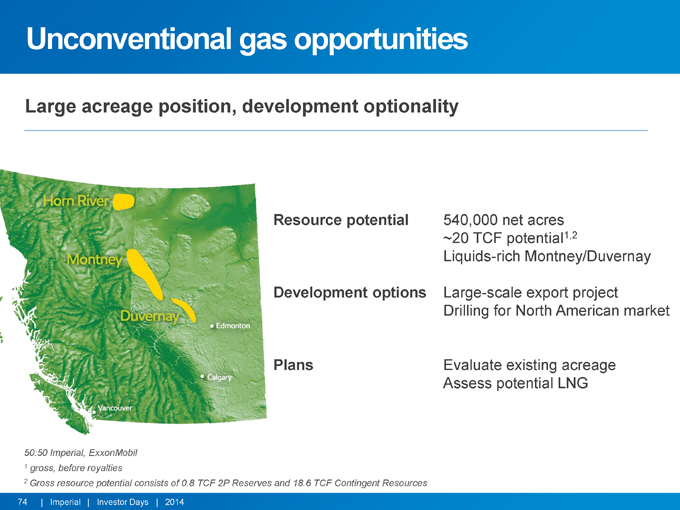
Unconventional gas opportunities
Large acreage position, development optionality
rce potential 540,000 net acres ~20 TCF potential1,2
Liquids-rich Montney/Duvernay
elopment options Large-scale export project
Drilling for North American market
Evaluate existing acreage Assess potential LNG
1 | | gross, before royalties |
2 | | Gross resource potential consists of 0.8 TCF 2P Reserves and 18.6 TCF Contingent Resources |
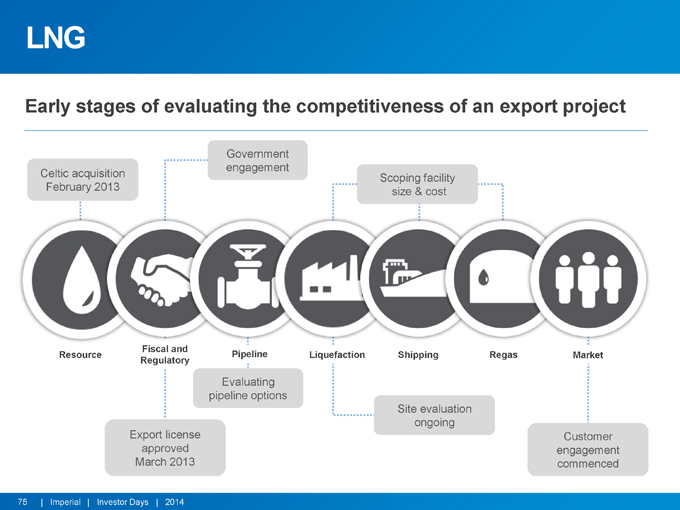
LNG
Early stages of evaluating the competitiveness of an export project
Government engagement
Celtic acquisition Scoping facility February 2013 size & cost
Fiscal and
Resource Pipeline Liquefaction Shipping Regas Market Regulatory
Evaluating pipeline options
Site evaluation ongoing
Export license Customer approved engagement March 2013 commenced
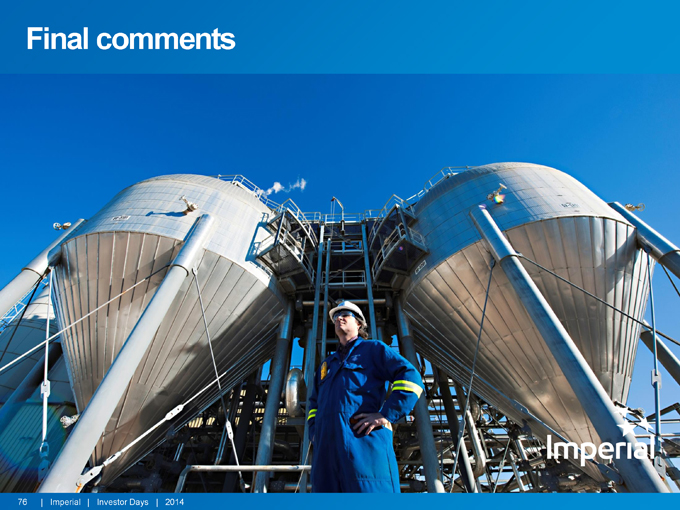
Final comments
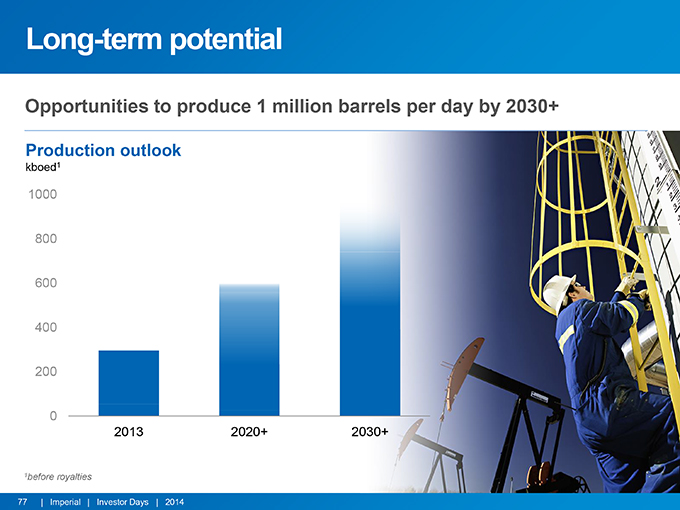
Long-term potential
Opportunities to produce 1 million barrels per day by 2030+
Production outlook
kboed1
1000
800
600 400 200
0
2013 2020+ 2030+
1before royalties
77 | Imperial | Investor Days | 2014
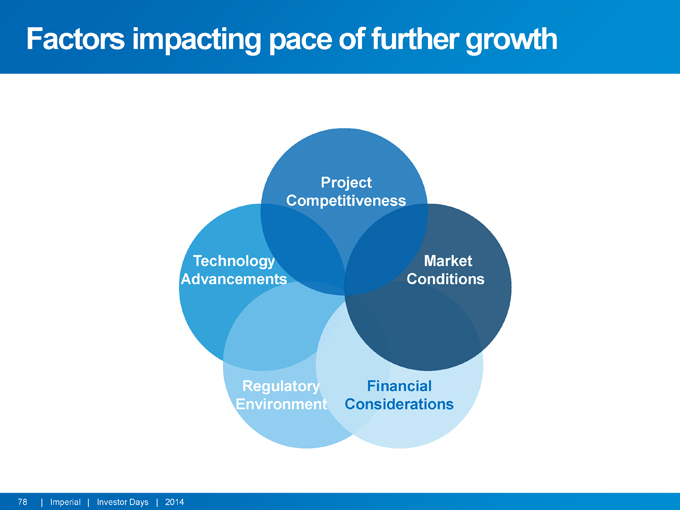
Factors impacting pace of further growth
Project Competitiveness
Technology Market Advancements Conditions
Regulatory Financial Environment Considerations
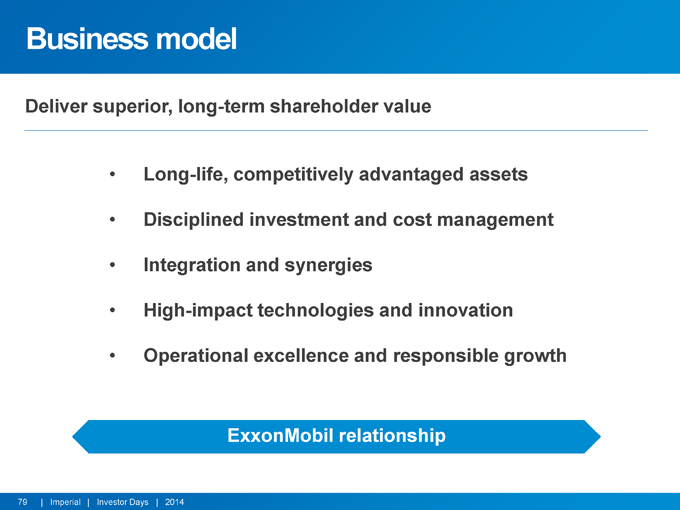
Business model
Deliver superior, long-term shareholder value
Long-life, competitively advantaged assets
Disciplined investment and cost management
Integration and synergies
High-impact technologies and innovation
Operational excellence and responsible growth
ExxonMobil relationship
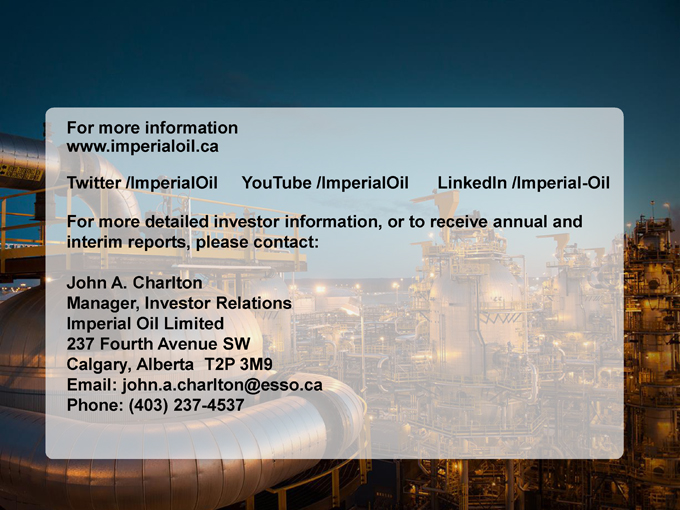
For more information www.imperialoil.ca
Twitter /ImperialOil YouTube /ImperialOil LinkedIn /Imperial-Oil
For more detailed investor information, or to receive annual and interim reports, please contact:
John A. Charlton
Manager, Investor Relations Imperial Oil Limited
237 Fourth Avenue SW
Calgary, Alberta T2P 3M9 Email: john.a.charlton@esso.ca Phone: (403) 237-4537
